SCIENCE FOR A RESILIENT FUTURE
NIWA YEAR IN REVIEW 2022




Buller Gorge (Cover). [Geoff Mackley] Reflections in Flooded Lake Ellesmere and Southern Alps (Inside Front Cover). [GettyImages]

To support the wellbeing of Aotearoa New Zealand’s people and business through
• improved management of the environment
• sustainable use of natural resources
• effective responses to global change
To deliver the science that will enable Aotearoa New Zealand to meet its environmental challenges and thrive in a rapidly changing world
We will innovate, generate new knowledge, and apply our science to
• provide industry opportunities
• transition to a low carbon economy
• adapt to a changing climate improve the health of our waterways and oceans
• care for our unique biodiversity
To achieve these advancements
• we will partner with Māori
• embrace new technologies
• support major science infrastructure
• collaborate with other science organisations and the sectors that apply our science products and services
New Zealand’s pre-eminent provider of atmospheric and climate science Climate change and variability
• High-precision weather forecasting
• Weather-related hazard forecasting
• Adaptation and mitigation
230 Science staff –New Zealand’s largest team of climate scientists
7,500 Climate stations –The National Climate Database with information from 7,500 climate stations covering New Zealand, South-West Pacific and Antarctica

$42M Annual investment –In weather and climate research
$18M Supercomputer –Enabling precise, highly localised forecasts
Presented to the House of Representatives pursuant to section 44 of the Public Finance Act 1989.
The NIWA Annual Report for 2022 is presented in two parts - the Year in Review and the Annual Report (Financial Statements). Collectively, these two documents fulfil our annual reporting responsibilities under the Crown Research Institutes Act 1992.
The Year in Review is an illustrated document containing the Chairman and Chief Executive’s report, descriptions of our research capabilities and performance, including our partnerships with Māori, work with collaborators and stakeholders, and an overview of our people. Both reports are available digitally at www.niwa.co.nz/about/annual-reports
Published by:
NIWA
41 Market Place, Auckland Central 1010 New Zealand
September 2022
ISSN 2744-3086 (print)
ISSN 2744-3094 (online) www.niwa.co.nz
Supporting the sustainable management of our freshwater resources
• Freshwater quality and quantity
• Biodiversity and biosecurity
• Sustainable use
• Flood forecasting
240 Science staff –New Zealand’s largest team of freshwater scientists
A national flood forecasting service – Providing river flow forecasts for 50,000 catchments nationwide

$40M Annual investment –Increasing knowledge of water quantity and quality
500 Hydrological monitoring stations – A nationwide network of water and soil moisture monitoring stations
Understanding, managing and maximising the benefits of our marine estate
• New Zealand’s Marine Estate
• Fisheries stock assessment
• Sustainable use of marine resources
• Biodiversity and biosecurity
• High-value finfish aquaculture
260 Science staff –New Zealand’s largest team of ocean scientists
Northland Aquaculture Centre –New Zealand’s leading science facility for finfish aquaculture
$67M Annual investment –In coast and ocean, fisheries and aquaculture science
State-of-the-art research vessels –Supporting the New Zealand science community

In the early hours of Tuesday 22 March, a rain gauge in Northland was filled with 103mm of rain in just one hour – the most ever recorded at a low elevation weather station in Aotearoa New Zealand. Just eight months earlier, NIWA recorded the highest flood flow ever measured in New Zealand – 7640 cubic metres per second in the Buller River. That was 17 times its normal flow and 35 times the Huka Falls when they’re in full flow. That’s an awful lot of water. Flood waters surged towards Westport, spilling out over the floodplain, and leaving more than 120 homes uninhabitable.

Our climate and our world are changing, fast. 2021 was New Zealand’s hottest year since records began, and we’ve had the three warmest winters back-to-back. Our climate scientists have a clear warning – we must brace ourselves for more frequent and intense storms in the years ahead. NIWA can’t stop it raining, but we can help communities prepare and adapt. As New Zealand’s leading environmental science provider, our ability to accurately forecast hazards is rapidly evolving. Forecasting is central to what we do –with our continually improving processing power and precise modelling, we can more accurately predict when and where heavy rain will fall, where it will go once it hits the ground, and what may happen when it gets there.
Our meteorologists and climate scientists, with concomitant investment in our data science capabilities and our High-Performance Computing Facility, have developed a state-of-the-art national river flow awareness tool. We can use this tool to translate high-resolution forecast data into advanced catchment flow projections – 48 hours in advance – for more than 50,000 catchments across New Zealand.
When Westport flooded last year, this tool played a key role in managing the inundation, helping save lives and property. Bob Dixon, Westport’s Civil Defence Controller, said the advice they “were receiving [from NIWA] around the modelling and predictions matched, almost to the letter, what was happening on the ground,” adding that “it was great science to have in [their] back pocket, giving peace of mind about the decisions [they] made.”
We aren’t stopping there. NIWA natural hazards modeller Dr Emily Lane is leading a five-year, multi-partner research programme – Mā te Haumaru ō te Wai – which, for the first time, will map flood hazard and risk through a national lens. Dr Lane and her team are working with researchers, iwi, stakeholders, and government to investigate flood inundation hazard and risk, co-developing fair and equitable strategies for communities to become more flood resilient.
These are just two of many forecasting programmes underway at NIWA. At the opposite end of the spectrum is our longestablished drought forecasting work, and we are currently working with the Ministry for Primary Industries to develop a new drought forecasting tool. The tool uses innovative climate modelling and the latest in machine learning. It will help farmers
and growers better prepare for periods of dryness and drought by updating daily, providing forecasts at a much higher spatial resolution than previously available.
Since 2014 we have been collaborating with fellow Crown Research Institute GNS Science on a risk modelling tool for natural hazards called RiskScape. RiskScape is a flexible, detailed framework for calculating natural hazard consequences, and part of its strength lies in a fully holistic approach that accounts for people, buildings, infrastructure and the environment. It passed a significant milestone in 2022, being launched to the public under open licence.
The RiskScape team took home the prize for Best Hi-Tech Solution for the Public Good at this year’s NZ Hi-Tech Awards, being personally congratulated on stage by Prime Minister Rt Hon Jacinda Ardern.
We also launched new and improved software for use in weather, climate and environmental forecasting – Cylc 8 This software is enhancing our environmental information service by improving the efficiency and complexity of forecasts. Cylc is open source and used throughout the world by organisations such as the UK MetOffice and the US Air Force.
To be forewarned is to be forearmed. Our corner of the world is highly prone to natural hazards – from flooding, which is our most frequent, to earthquakes, which are our most costly and deadly. We are using world-leading science, inspiring and embracing national and international collaboration, to ensure the best brains in the business are engaged to tackle these threats.

New Zealand’s hottest year since records began, and the three warmest winters back-to-back
The July 2021 Westport flooding event included the largest direct measurement of river flow ever recorded by NIWA. It flooded over 400 houses and incurred insurance costs of around $56 million. NIWA flood risk calculations and modelling (below) helped inform the decision to evacuate residents ahead of time. [NZ Defence Force]
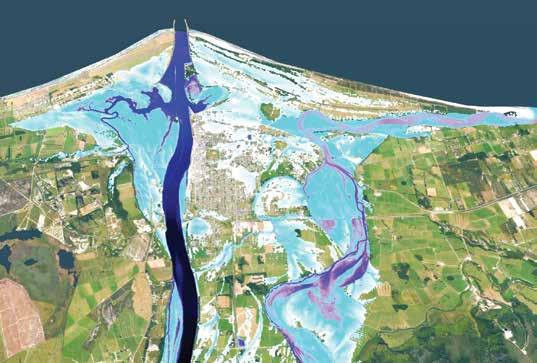

NIWA’s new state-of-the-art national river flow awareness tool can translate high-resolution forecast data into advanced catchment flow projections –48 hours in advance – for more than 50,000 catchments across New Zealand.
Despite the year’s challenges, the exceptional demand for our services is unabated, and we created 13 new permanent and fixed-term positions to help meet this challenge, growing our total staff to 725. We also welcomed three new board members – Janice Fredric, Professor Margaret Hyland and Dean Moana.
NIWA finished the financial year strongly. Thanks to the commitment of our dedicated staff and management in pursuing all revenue opportunities, careful handling of costs and maximising operational productivity and efficiency, NIWA’s full year revenue was $170 million, just $1 million short of Budget.
Investment in science infrastructure for national benefit increased substantially this year – from $23 million in 2021 to $41 million in 2022 – reflecting costs associated with the new science facilities in Hamilton as they near completion and progress on the experimental, commercialscale Recirculating Aquaculture System at our Northland Aquaculture Centre. Both are due for completion next year. NIWA was also successful in the 2021 Marsden Fund, being awarded funding for two standard applications, for a total of $1.826 million. We are also a collaborative partner with the University of Otago and Victoria University of Wellington on three other successful Marsden proposals. Pleasing results, given the fund is highly competitive – with a success rate of just 10.2%.
Investment in science infrastructure in 2022
June 2022
In thousands of New Zealand dollars 2022 2021 2020 2019 2018
Revenue and other gains 170,233 *176,887 *158,860 161,292 151,416
– Research 95,614 109,111 93,800 94,901 91,516
– Commercial science 74,618 67,775 65,059 66,390 59,899
– Other income 1 1 1 1 1
Profit before income tax 8,958 22,594 9,982 8,708 9,074
Profit for the year 6,470 16,263 7,370 6,247 6,472
Capital expenditure 40,817 23,080 14,757 21,460 33,573
Adjusted return on average equity (%)
5.0 13.9 6.9 6.2 6.9
Return on average equity (%) 4.3 11.6 5.7 5.1 5.5
* Includes $8.27 million from the Government’s COVID-19 Response and Recovery Fund (CRRF).


Despite the national and international challenges presented by COVID-19, we achieved all 24 of our science Key Performance Indicators this year.
The impacts of climate change are no longer warnings. They’re reality. After another year of extreme weather events, the need for NIWA’s expertise is compelling.

In a demonstration of NIWA’s significance as a global climate change player, Principal Scientist Dr Olaf Morgenstern contributed as a lead author of Chapter Three of the IPCC Sixth Assessment Report, which looked at human influence on the climate system. The future was mapped out in five scenarios, and the key message reinforced
the understanding that widespread and rapid changes in the global climate system are down to human influence.
Researchers at NIWA’s Atmospheric Research Station in Lauder and NASA’s Goddard Flight Center have been examining the impacts of 2020’s devastating Australian bushfires and have discovered unprecedented changes to our stratosphere, which is where our protective ozone layer lies. Changes which revealed an important gap in our understanding of ozone chemistry. This discovery was both surprising and worrying, with wildfires predicted to become more frequent and more intense as the planet warms, the likelihood of ozone depletion is increased. A little closer to the ground, our air quality experts completed a ventilation study in three schools in collaboration with the
NIWA infographics provided the Ministry of Education with innovative, easily understood, messaging about the benefits of ventilation in classrooms.

Ministry of Education. The advice the experts gave was that people use natural ventilation – such as opening doors and windows – to reduce the spread of COVID-19. This practice reduced both the number and severity of COVID-19 cases across the country, and the team subsequently secured a $500,000 project from the government to continue this work.
When Westport’s devastating floods hit in July last year, NIWA’s national flood awareness system played a key role in deciphering the deluge of data coming at the West Coast Regional Council’s exhausted staff. Forecasting hydrologist Dr Céline Cattoën-Gilbert and her colleagues provided real-time advice on how to deal with the events that were unfolding, giving the council staff invaluable extra hours to protect property and evacuate people safely. The space industry is expanding rapidly all over the world, and NIWA has always been an integral component. Our involvement with MethaneSAT – a joint satellite initiative by the US and New Zealand – is reaching new heights, with the launch of a satellite next year. In a significant milestone, the New Zealand team has identified the best agricultural targets across the globe for the
satellite to observe methane emissions and identify key targets for emission reduction in the battle to tackle climate change.
New Zealand’s freshwater is often held to be one of our natural advantages. Yet the quality of the water in our lakes, rivers, streams, reservoirs and wetlands is highly variable, as is our water availability.

In common with almost everywhere else in the world, our glaciers are retreating rapidly, and we are considering supplementary storage for hydroelectricity generation.
Unlike much of the world, however, we have enough water – it’s just not always in the right place. There is much for NIWA’s team of 240 freshwater experts to do. Detection and management of invasive submerged weeds cost millions of dollars annually, but we have developed a solution – a portable invasive species detector that can be strapped to survey boats. This artificial intelligence-based detector has been trained to identify targeted invasive weed species and log their locations in real time, and it will enable agencies to survey far larger areas more efficiently than is currently possible.
Estuaries are a point of interconnectedness, being the gateway between freshwater and saltwater. NIWA has channelled this interconnectedness through a twoyear project called Ki uta ki tai: Estuaries, thresholds and values. The programme will assess how different land contaminants interact with each other and affect estuarine health. Twelve estuaries have been selected as case studies, and our researchers are working with whānau, hapū, iwi and community groups to identify their aspirations.
Wetlands are often overlooked, but they have highly significant and variable roles to play in maintaining environmental health, buffering flows, decreasing downstream flooding and boosting biodiversity. Well-designed constructed wetlands are a water quality restoration tool that can reduce levels of sediment, nutrients and microbes such as E. coli. This can significantly improve the water quality exiting the wetland and the ecology of downstream water bodies. In association with DairyNZ, we have been monitoring a purpose-built wetland on a Waikato farm, and developing guidelines on design, construction, maintenance and
performance. The guidelines were launched in May this year and are freely available on DairyNZ and NIWA websites. We are also working with the Ministry for the Environment and the Department of Conservation to update the Fish Passage Guidelines in 2022, informed by a $7.2 million, five-year Endeavour Fund research programme that NIWA is leading to develop tools and guidance to reduce barriers to freshwater fish migration and improve the outlook for macroinvertebrate biodiversity and the abundance of iconic fish such as whitebait or freshwater eels.
Over the course of this year, we have made significant progress on the construction of an experimental, commercial-scale Recirculating Aquaculture System (RAS) at the Northland Aquaculture Centre in Ruakākā. Built as a joint venture with Northland Regional Council, this land-based system is the first of its kind in New Zealand and will produce a quarter of a million kingfish (600 tonnes) annually.
RAS answers the call for a more sustainable aquaculture industry. It offers immediate and near total control over the stock, with a significantly smaller environmental footprint due to its passive, secure
environment, clean discharge and no requirement for servicing vessels. Completion is expected in early 2023.

At the end of 2021, NIWA’s mid-sized research vessel Kaharoa completed a three-month Argo deployment voyage north of the equator, supported by the University of Washington, Scripps Institute of Oceanography and the Commonwealth Scientific and Industrial Research Organisation. For the next 5 years, the floats will provide freely accessible tropical ocean data critical to climate studies of global heat changes and circulation in the deep ocean. Incidentally, the vessel deployed its 2,000th Argo float on the voyage. This represents nearly half of the total number of floats currently operating across the global ocean, in what is the world’s largest marine science project.

A collaboration with the Deep South Challenge: Changing with our Climate showed that New Zealand could experience very long and “very severe” marine heatwaves by the end of the century.
It also found that the intensity of future marine heatwaves will increase by between 20% (best case) and 100% by the end of the century – what we now record as an intense marine heatwave will start to become the norm.
A high-resolution mapping project has produced the first ever global estimates of coastal habitat damage caused by high-tonnage vessel anchoring. Working in collaboration with researchers from the University of Auckland and Auckland University of Technology, we used highresolution seafloor data, real-time ship tracking information, scientific literature and the news media. The damage is severe, long-lasting and widespread, with up to 6,000 square kilometres of damage worldwide. In Picton, for example, high-tonnage vessel anchors excavate the seabed by up to 80 cm, displacing enough sediment to fill an Olympic swimming pool.
Our facilities in Hamilton, Wellington and Christchurch are nearing the end of their useful life, and our strategic plan is to replace them with specially equipped, state-of-the-art, sustainable developments.
The Hamilton facility is the first under development and, despite minor delays caused by COVID-19 and supply chain issues, it will be completed by mid-2023 and within the $45 million budget.
The new replacement vessel for Kaharoa has been designed by naval architect Skipsteknisk and will accommodate 6 crew and up to 13 science staff. [Skipsteknisk]
These new complexes will protect NIWA’s ability to deliver its scientific activities for the foreseeable future. Their design reflects our sustainability values and will support our staff in being more flexible, collaborative, and creative, with specially equipped laboratories – helping ensure we can continue to provide the science needed to meet New Zealand’s rapidly changing needs.
Another upgrade has reached a significant milestone. Kaharoa – NIWA’s mid-sized marine research vessel – is an essential tool for oceanographic and fisheries research, but at 40 years old, it has significant operational limits and will be retired in 2025. Earlier this year NIWA signed a contract for the construction of its replacement – a 36-metre state-of-the-art research vessel that will be cost-effective, safe and efficient and capable of supporting future technologies and multidisciplinary science.

This vital upgrade will allow NIWA to meet New Zealand’s future marine science needs, including the provision of data to inform fisheries management, critical oceanographic research – such as the response of the marine environment to a changing climate – biodiversity and biosecurity research and contributions to hazard risk management. This is a very significant investment in New Zealand’s research infrastructure, and an exciting development for NIWA and the marine science community.
Holding 90% of the world’s ice and 80% of its freshwater, Antarctica has a profound effect on the planet’s oceans and climate.
In February, a multidisciplinary group of NIWA researchers completed a mission to the world’s coldest continent, where they studied the Ross Sea Marine Protected Area (MPA). Three notable accomplishments were from Dr Denise Fernandez, who used Argo floats to collect information on the water column in the Ross Sea at different depths – these will stay in the ocean for several years; Dr Craig Stewart, who produced a real-time map of melt rates at the ice shelf’s edge; and Dr Craig Stevens, who drilled into an underwater river called the Kamb Ice Stream, discovering an unexpected swarm of life and recording an equallyunexpected pressure change as the tsunami from the Hunga Tonga–Hunga Ha’apai eruption made its way through the cavity.
The Harvard Business Review described data science as the “Sexiest Job of the 21st Century”. We are living in a digital world and it’s hard to see a future that isn’t almost entirely digital. NIWA is a significant investor and innovator in artificial intelligence (AI) and computing solutions to ensure our research continues to provide the best scientific advice and solutions.
Maui, the most powerful machine in NIWA’s High-Performance Computing Facility, is getting a mid-life makeover. The Cray XC-50 supercomputer was commissioned in 2018 and provides the processing power needed to deliver advanced data science services across NIWA’s research platforms. The addition of new graphic processing units will boost storage and deliver up to a four-fold increase in performance.
This year, it was announced that Wellington is one of only 15 cities worldwide – selected from 631 applications – to be awarded US$1 million for the Bloomberg Philanthropies’ Mayors Challenge for the Digital Twin project. The project will be completed over the next three years and will visualise climate change and its consequences through virtual reality. NIWA scientists will contribute hypothetical scenarios using coastal modelling, coastal engineering and social science methodology. We are also designing an interactive map, so people can see what the Wellington coastline would look like with different severities of sea-level rise.
Floods devastate large swathes of our country and communities, but can ultimately bring people together, so NIWA has utilised this ‘people power’ by launching the free NZ Flood Pics citizen science app. The public have been asked to contribute photos of flood-affected areas to a national database, which will support improved understanding of flood hazard and risk.

Scallops are a national treasure, but there are major population declines nationwide. Collaborating with data scientists at the University of Canterbury, we have been working on an innovative, non-invasive alternative for surveying and harvesting them. Several thousand images of scallops were captured by underwater cameras mounted on an underwater drone, and then used to design algorithms to detect scallops.

 Tiny eyes (about the size of a poppy seed) help scallops sense movement or predators (top). AI technology identifies individual scallops by sliding computer-generated stencils over video images (bottom). [James Williams]
Tiny eyes (about the size of a poppy seed) help scallops sense movement or predators (top). AI technology identifies individual scallops by sliding computer-generated stencils over video images (bottom). [James Williams]
This technology will provide accurate, efficient, safe and environmentally friendly surveys to improve our understanding of benthic habitats and marine ecosystems.
Māori are intimately connected to the environment, and their worldviews are based on centuries of observation and anticipation of nature and genealogy. This complementary knowledge system can support kaitiakitanga and provide environmental research excellence, ensuring critical scientific endeavours are enduring, holistic, and steeped in culture. We continue to grow and strengthen our ties and partnerships with Māori. Te Kūwaha is NIWA’s National Centre for Māori Environmental Research –a dedicated Māori research team who undertake research, provide services across our science, and enhance the social, environmental, and economic aspirations of whānau, hapū and iwi, Māori communities and Māori business.
This year was particularly poignant, with New Zealand celebrating its first ever official Matariki public holiday. Throughout our sites, we remembered those lost since the last rising, gave thanks for the present and looked forward to the year ahead. Events included the inaugural Matariki celebration in a packed house at NIWA Auckland, and speakers and artists enlightened NIWA Hamilton about the meaning and purpose of Matariki through their worldview.
NIWA’s Te Kūwaha and People & Capability teams have been working together to develop a cultural competency framework for NIWA – “Te Puāwaitanga” – a concept that denotes learning and growth. Late last year, we completed an assessment of the cultural competency work underway across the public sector and settled on a modified model developed by Te Arawhiti (Office for Māori/Crown relations). The conceptual framework will guide us in assessing current competency levels and prioritising resources, while providing a benchmark for progression and success. As part of this work, we launched several new digital learning tools, such as the Taihoro Nukurangi app and Te Punga, and we are committed to building on this base to create enduring change.
NIWA is also managing a two-year pan-CRI project to increase Māori participation in the science system, develop strategic pathways for graduates and work collaboratively across CRIs to provide mentorship and future opportunities. The project team continues to grow and recently welcomed NIWA social scientist, Jordan Luttrell, who brings a wealth of knowledge and experience in research evaluation methods and tools.
There is a Māori proverb that speaks on the value of collaboration: Nāu te rourou, nāku te rourou, ka ora ai te iwi or ‘With your food basket and my food basket the people will thrive’.
It started with a bang. On 15 January, the Hunga Tonga–Hunga Ha’apai (HT–HH) volcanic eruption reached a very large and powerful climax. The biggest explosion ever recorded by modern instrumentation sent shockwaves around the world. Some 16,500 km away, clouds above the UK lifted. Tsunamis killed two people in Peru and were detected in rivers deep under the Antarctic continent. Tonga was covered in ash and cut off from the world when its underwater internet cable was severed. For months, New Zealand’s skies turned dramatic shades of red and purple.
A global event of this scale required an equally global effort to understand what happened and investigate the consequences. Thanks to generous support from Japan’s The Nippon Foundation,
the receptivity of the Nation of Tonga, and innovative technology from the UK, the NIWA-Nippon Foundation Tonga Eruption Seabed Mapping Project (TESMaP) was born.
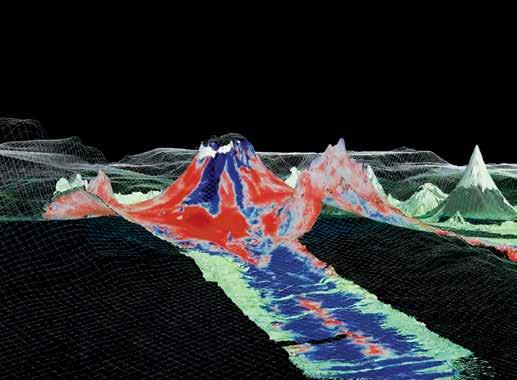
On 9 April, NIWA’s deepwater research vessel Tangaroa set sail from Wellington for a month-long expedition to complete an undersea survey of the HT–HH volcano. The voyage achieved all its objectives and more. Tangaroa surveyed a remarkable 22,000 square kilometres of seabed in high resolution. Our scientists characterised and sampled sediments and rocks, captured 7,000 photographs and 32 hours of video footage, and took samples through the water column to identify the state of any surviving biota. The scientific learnings from this mission are vast and growing. The second part involves a high-tech USV (uncrewed surface vessel) from UK-based SEA-KIT International surveying the caldera, remotely operated all the way from Essex, England. The results from this survey are due later in the year.
The HT–HH eruption highlighted just how remote and vulnerable our neighbouring Pacific Island Countries (PICs) are, being especially susceptible to natural disasters and climate change. To help build their resilience, the New Zealand Ministry of Foreign Affairs and Trade (MFAT) is funding NIWA and the Pacific Community (SPC) for a three-year project called PARTneR-2, in which we are collaborating with six PICs to help them better prepare for and respond to disasters. PARTneR-2 will address a critical gap across the Pacific region – the low availability and use of affordable and easily applied hazard
risk modelling tools for risk-informed and effective development decisions.
Even further afield, NIWA is contributing to an international effort to help developing countries reduce the impact of biofouling on aquatic-based industries and environments. Biofouling is the build-up of aquatic organisms on underwater surfaces of marine infrastructure such as vessels, platforms and aquaculture installations. With the International Maritime Organisation GloFouling Partnerships Project, NIWA will help develop an economic assessment guide to determine the benefits of introducing a biofouling policy in 12 developing countries, including Indonesia, Mexico, Jordan, and Peru.
Back in New Zealand, NIWA has teamed up with the other seven Crown Research Institutes (CRIs) to create the National Environmental Data Centre (NEDC) website, making the environmental information held by CRIs more accessible to all New Zealanders. The datasets include a huge range of information from climate and atmosphere, freshwater, land and oceans, including biodiversity and geological data. They will not only advance science, but also have a myriad of uses by Māori, central and regional government, businesses, researchers and the public.
One of the starkest takeaways from the last two pandemic-affected years is proof that people can come together to achieve extraordinary things, without having to be in the same room, on the same site or even in the same country. New Zealand’s remoteness doesn’t hinder successful scientific collaboration – as our long-standing successful partnerships with the MetOffice in the UK and the National Oceanic and Atmospheric Administration (NOAA) in the US demonstrate, our work is often global, and our collaborative research with international partners has been just as fruitful as that with our partners here in New Zealand.
As we write this review, one-third of Pakistan is under water, sunken medieval villages have reappeared in European reservoirs and New Zealand’s Taranaki ski season may go a whole season without opening. For decades, the science has shown that to avoid the worst effects of climate change, global temperatures must
not exceed more than 1.5°C above preindustrial levels. Yet, we are already living with the impacts of a warming climate, and they are often dramatic and devastating. We are horrified, along with the rest of the world, but we are not surprised, because the world is already 1.1°C warmer than it was in the 1800s, and emissions are continuing to rise.
That is why, as the nation’s leading climate, freshwater and marine science organisation, NIWA must show strong leadership in our commitment to the target of carbon neutrality by 2025, consistent with the Government’s objective. We recognise that our research often has a substantial environmental footprint as we seek the solutions to allow government, Māori, stakeholders and the public generally to better manage their lives and their livelihoods, and we have continually adjusted our operations to minimise their environmental impact while ensuring we met our customers’ needs.
Over the course of this year, we have worked under the Toitū Carbon Reduce Programme to verify and report greenhouse gas emissions and refine our strategies to manage and reduce impacts. Compliance
with this programme is independently verified annually, and we participated in our first independent baseline certification and emissions reporting and monitoring accreditation in July.
With construction accounting for 39% of global emissions, we’ve put sustainability at the heart of our programme to replace our ageing facilities in Hamilton, Wellington and Christchurch – utilising reusable materials, renewable energy and efficient practices. The emissions from our research vessels are our biggest carbon contributor, but the Kaharoa replacement will be a low emissions vessel and we tightly manage fuel use across the rest of our fleet. As with our motor vehicle fleet, we will continue to replace our boats when practical alternatives are available, and our long-standing adoption of advanced communications technology allows virtual meetings and continually challenges us to ask the question: “Why fly?”.
Our most important and impactful contribution, however, is our science. NIWA’s research helps develop solutions to the world’s environmental problems. By ensuring our scientific endeavours have sustainability at their heart, we can continue to help build a healthy and productive world.
NIWA’s new Hamilton facility on the University of Waikato campus is scheduled for completion in mid-2023. [Blanton Benjamin, Foster Construction]

You become strong by lifting others up, not pulling them down. NIWA has an ongoing commitment to build a future-ready, resilient workforce – one that is skilled and highly diverse. A skilled science sector will deliver innovation, growth, and quality, while a diverse sector will deliver creativity, connections, and accessibility.
This year, NIWA co-supervised 67 PhD, 28 Masters and 4 Bachelor students nationwide, and financially supported 4 postdoctoral and 15 PhD positions. We are continuing to build Māori science capability through our oversubscribed Māori graduate intern programme. In 2021, the interns took part in our Cultural Keystone Species programme, which had hapū-driven research at its heart and was established to create more visible pathways for Māori science graduates.
NIWA sponsors seven main city science and technology fairs and eight regional fairs, with our staff also serving on the judging panels. These fairs provide the opportunity for young people to think and act scientifically. By leading projects based on their own interests, they are taught to see science in the world around them and recognise it as a solution to global problems, large and small.

This year’s fairs took place in person for the first time in two years and were enthusiastically welcomed by those taking part. Hundreds of students participate in each fair, showcasing innovative and creative projects on anything from an investigation about food serving sizes, to the future of rocket propulsion, and even the invention of a UV-powered cat bed.
We are the principal science partner of BLAKE and work closely with them to support their focus on environmental leadership, especially with the nation’s youth. The 2022/23 cohort of five young New Zealanders will gain perspective in remote locations around New Zealand and Antarctica, building relationships and experience in the practicalities of science. We also sponsor the environment category of the annual BLAKE Awards and help inform their ‘Inspire for Teachers’ programme, which provides environmental education and leadership development for teachers.

We are also part of the collective CRI sponsorship of the Sir Paul Callaghan Eureka Awards, and we provide an additional scholarship for a secondary or tertiary student who delivers the best presentation on climate, freshwater or marine science.
We are proud of the busy and successful year we’ve had at NIWA. Many of our projects, such as the property programme, TESMaP and our flood and drought forecasting work will be ongoing for the foreseeable future.
We would like to thank everyone at NIWA – the Board, Executive Team and staff – for their dedication and support, particularly at the end of such a turbulent year. We knew that the pandemic would be tough, and it affected us in ways we could not have predicted. However, we remained resilient, and we adapted, emerging stronger, busier, and more focused than ever.
COVID-19 put a spotlight on science, highlighting just how vital it is for finding solutions to our toughest problems. It also showed us that scientific endeavour can be filled with hope and that it touches the lives of everybody. NIWA exists to enhance Aotearoa New Zealand’s environment, economy and the lives of its people.
By leading world-class environmental research, technology transfer and knowledge sharing, we play a critical role in guiding a resilient future for our nation and the rest of the world.
Barry Harris Chairman Morgan Chief ExecutiveThe following section of this Year in Review, ‘NIWA Science’, pp. 16–45, includes selected examples of how our science is applied for the benefit of the nation.
Newlands Intermediate student Dominic Holden (11) won the 2022 NIWA Wellington Science and Technology Fair with his project which aimed to reduce carbon emissions in the construction industry. [Chris Holden] JohnThe judges said this dramatic glacier image, taken from inside an ice cave, was made more impactful with the inclusion of the sliver of bare rock. They noted the lines, the texture and “a beautiful use of icy blue hues”.
 Brewster Glacier Emerging Photographer Award WinnerFraser Goodmanson
Brewster Glacier Emerging Photographer Award WinnerFraser Goodmanson



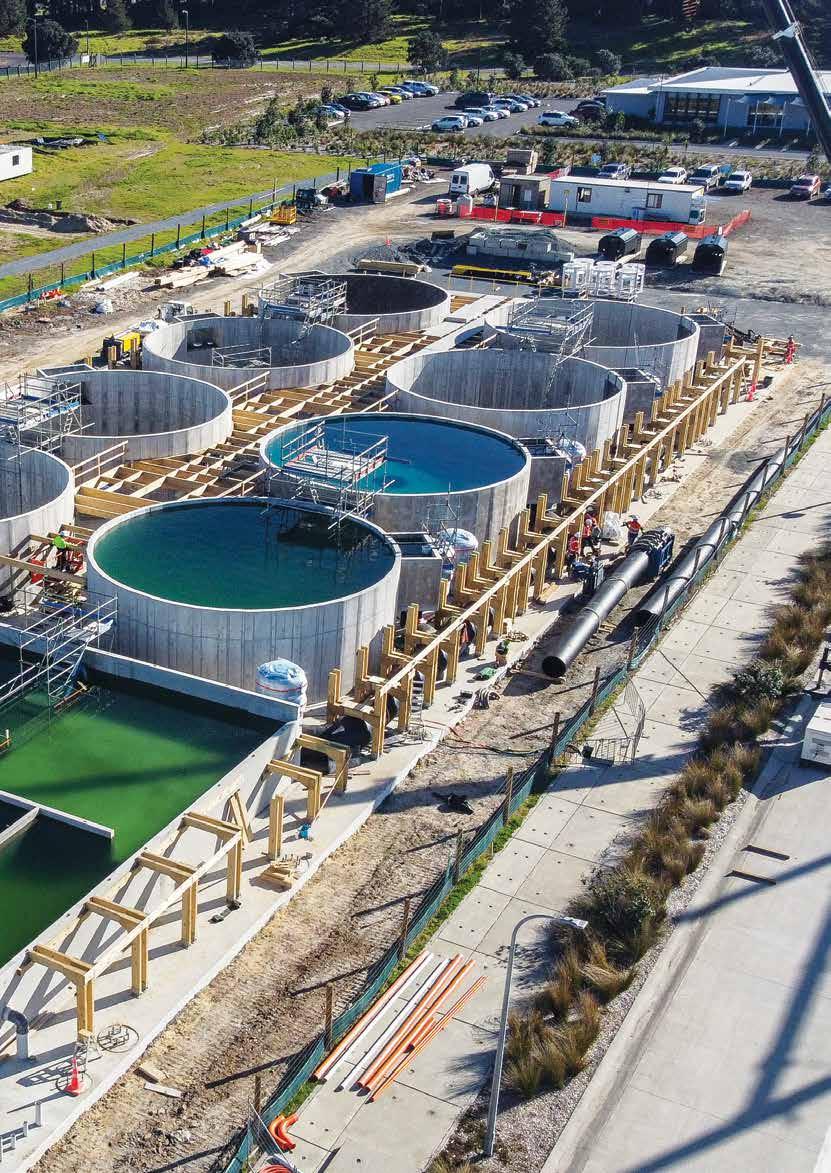
Land-based aquaculture can have significant economic, environmental and social benefits for New Zealand, and construction of the nation’s first commercial-scale recirculating aquaculture system (RAS) is well advanced to demonstrate this at NIWA’s Northland Aquaculture Centre in Bream Bay.
Land-based aquaculture using RAS has significant advantages – it offers total control over the stock, much higher feed conversion rates and a significantly smaller environmental footprint.


The construction of eight 350,000-litre fish tanks with two independent water treatment plants is due for completion and expected to be operational in early
2023. When operating at full capacity, the unit will demonstrate the practical use of this technology for the commercial, whole-of-cycle production of premium kingfish, and it will sustainably produce about 600 tonnes of kingfish every year.
Our kingfish – called Haku (kingfish in Te Reo Māori) – are already served at more than 65 top class restaurants across the country, where they are prized for their high quality, rich creaminess, superior texture and sweet flavour.
Our kingfish are harvested at 12 months, when they weigh 3–4 kgs. [Stuart Mackay]
pipe intake on the Acton Irrigation Scheme. Water from the small pond then runs through a filter and into the piped delivery system. [Rod Mckay]

As fresh water becomes increasingly scarce, its usage comes under greater scrutiny. For high-use irrigation, water-use efficiency is key. NIWA has been working with large irrigation schemes around the Canterbury region for more than two decades, and the Acton Irrigation Scheme near Rakaia has been the focus of some recent water-use efficiency work.

The scheme is working to replace leaky, open-channel distribution races with a piped system, and NIWA has been integrating the monitoring and control of the new piped delivery system with the intake and storage systems. This will allow the system to reduce – ideally eliminate –water losses, and therefore provide more efficient use of water taken from the river source.
The new controls that manage the delivery of water to on-farm ponds allow the farms to take water when it’s available and then store it. This can then be saved for when it is needed, and it provides more surety of supply and a more efficient use of water than previously, when it was ‘use it when you can, just in case’. That scenario caused wastage and overwatering.
The water delivery system has been further enhanced by the addition of on-farm pond level monitoring. This enhances the scheme’s ability to assess the need for water and the capacity available.
TheNIWA fisheries scientists have been testing innovative technologies to help them count fish. They have been working with New Zealand drone company X-Craft who developed Nemesis, a 6-metre autonomous vessel equipped with artificial intelligence software and data-gathering equipment which includes a batterypowered echosounder to estimate the size of fish populations.

The vessel performed well in its first deepwater test run in Cook Strait in February, coping with the strong tides. The next steps are to carry out trials in the Hauraki Gulf using the echosounder to look for small pelagic fish, as well as potentially adding a passive acoustic device to listen for whales at the same time.
This type of technology could complement the work being done on larger vessels, because it can operate over a wider area or time, collecting quality acoustic data in depths up to 600 metres. The vessel can be programmed to follow a specific track and is equipped with anti-collision technology.
Scientists hope to be routinely using this type of vessel for monitoring fish within the next five years, leading to improved estimates of abundance, with the ultimate outcome of better management of our fish populations.
NIWA is improving the way it collects information on fisheries by using alternative survey platforms such as Nemesis, an autonomous surface vessel equipped with echosounding technology. The vessel is quiet, cost-effective and can cover areas not surveyed by large research or fishing vessels. [Lana Young]
A collaboration between mussel experts, climate scientists and data scientists has produced a publicly available webtool that can help forecast mussel yields. Designed predominantly for New Zealand’s largest greenshell mussel industry area – the Pelorus Sounds – the tool uses climate data, especially sea surface temperatures, and historical mussel yield information to predict mussel growth, quality and yields for the coming season.
The new tool draws on historical mussel ‘crop’ performance, and uses advanced data modelling methods, more reliable seasonalscale weather forecasts and better remote sensing data.
Drawing these factors together will help forecast mussel condition in the upcoming season. This in turn aids decision making in the industry – a better understanding of mussel quality will improve business projections.

The webtool may also be useful for fish farmers and other sectors because it shows current ocean temperatures around New Zealand, where the seas are warmer or cooler than normal and where marine heat waves might be. [NIWA]
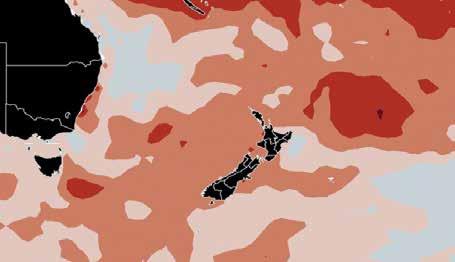
• Tools and advice to support climate change adaptation and mitigation

• Measure and understand greenhouse gas sources and pathways
• Communicate the science of climate change
• Customised data and tools for optimal electricity generation
• Minimise potential environmental impacts from renewable energy
• Small-scale, multi-source power for self-sufficiency and resilience

• Determine local to global sources and sinks of greenhouse gases
• High-precision, long-running measurement series to understand the drivers of climate change
• Assess the effectiveness of measures aimed at reducing greenhouse gas emissions
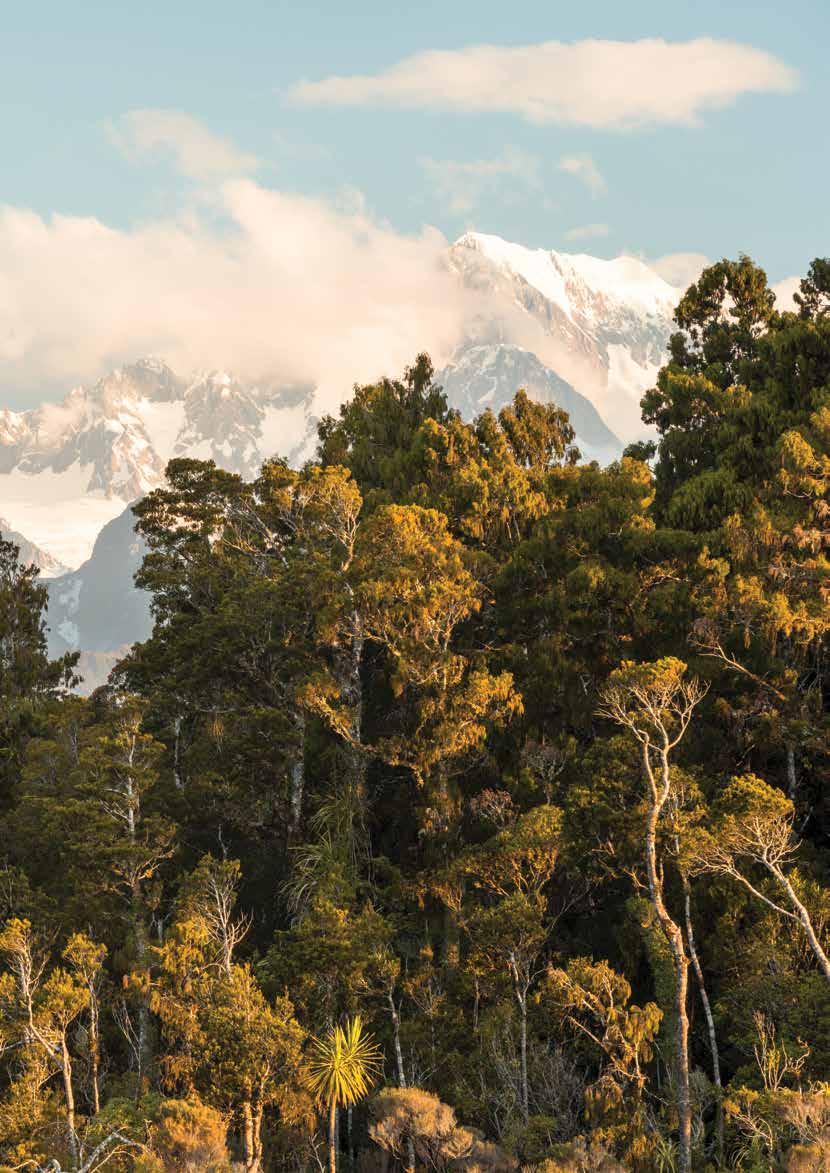
NIWA carried out extensive survey work at Lake Onslow to provide an initial environmental reference point before any development takes place.
[Andrew Willsman]
Research is underway to investigate the use of pumped water storage to support hydroelectricity generation during dry years, when there is insufficient water storage in existing hydropower lakes.

The large and diverse NIWA team working on the project completed an environmental baseline study which included a bathymetry survey, monitoring the effects of weather and climate on the lake, hydrodynamic modelling, a fish food-web study, examining the impacts of pumped hydroelectric energy storage on lake ecology and assessing macrophytes and potential biosecurity
issues. They also investigated potential greenhouse gas emissions. Our science has informed the first phase of MBIE’s feasibility study.
In addition to the baseline study at Lake Onslow, we led a nationwide GIS scan of potential sites for a pumped storage system and we also assessed the variability and correlation between the potential for hydro, wind and solar energy under future climate scenarios.

NIWA has developed automated habitat mapping techniques which are being applied to mangrove forests and seagrass meadows around New Zealand to help determine the role our estuaries can play in achieving greenhouse gas emission reduction targets. There is increasing scientific and policy interest in this globally, and a key step involves accurately quantifying the distribution of estuarine vegetation to assess its role in carbon sequestration – so-called blue carbon habitats.
Researchers are exploring the use of satellites for remote hyperspectral imaging. This technology takes pictures at hundreds of closely spaced wavelengths. Describing each point of an image (pixel) by hundreds of numbers, rather than just the three of our red/green/blue vision, gives a considerable gain in information. It can identify the signature of different habitats, including plant types, and its application in estuaries is being further explored to assess health, productivity and carbon storage provided by these habitats. It could also be used to identify multiple plant species in saltmarshes, which are threatened habitats in New Zealand.
Aerial remote sensing provides a costeffective approach for mapping extensive seagrass meadows, like this site near Tauranga Harbour, to help assess blue carbon – the carbon stored in coastal and oceanic ecosystems. [Carolyn Lundquist]
Regional councils and the Department of Conservation will be able to use the mapping tool to determine the location and quantity of mangrove and seagrass habitats for long-term monitoring. These maps will be used in an MBIE-funded Smart Idea to estimate national blue carbon inventories. Refinement of the national inventory is crucial to support mitigation efforts as the country transitions to a low carbon economy.

The mauri of the Raukūmara Range on the East Cape – ancestral ngāhere of Ngāti Porou and Te Whānau-ā-Apanui –has been damaged through decades of destruction by deer, goats, possums and human land-use changes.
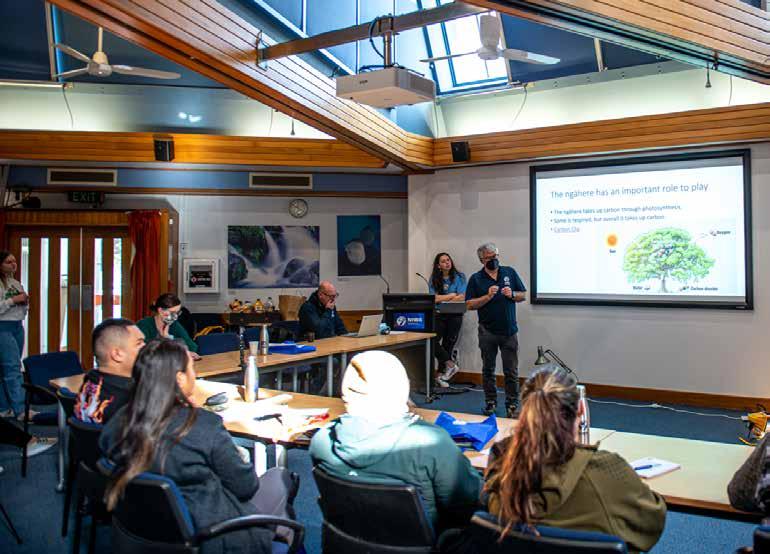
NIWA’s CarbonWatch NZ researchers have teamed up with the Raukūmara Pae Maunga restoration project, which includes the two iwi and the Department of Conservation Te Papa Atawhai – an ambitious project to regenerate the pestravaged Raukūmara Range on the East Cape. The collaboration includes knowledge sharing between partners, including working together to understand the atmospheric signals from the forest.
CarbonWatch NZ is investigating carbon emissions and uptake across cities, forests and grasslands. The programme will monitor the uptake of CO2 across the Raukūmara ngāhere, and, as pest control ramps up and the forest regenerates, the researchers hope that this will result in increased CO2 uptake. Meteorological stations have been installed on either side of the range and CO 2 monitoring is being established.
MethaneSAT, due to be launched in the first half of 2023, will measure agricultural emissions from 200 targets globally. [MethaneSAT LLC]


The MethaneSAT research team in New Zealand has identified the best agricultural targets across the globe for satellite observation of methane emissions. While the team are organising groundbased measurements, they are also preparing for the satellite’s launch next year.
NIWA’s Dr Sara Mikaloff-Fletcher is leading the MethaneSAT agricultural research programme, part of an international space mission helping to tackle climate change. MethaneSAT‘s core purpose globally is to gather data to inform a reduction in methane emissions from oil and gas sources; research in New Zealand, funded by MBIE, is focused on reducing global emissions from agriculture.
The New Zealand team has identified about 200 agricultural targets, each around 200 by 200 kilometres in size, across every continent except Antarctica. These targets, which are focused on ruminant farming and rice growing, were identified from data about methane emissions, land use and weather patterns.
Once the satellite is launched, it will scan about 20 to 30 targets each day – a mix of agricultural targets, oil and gas production sites and potentially even targets such as landfills and mining sites. By verifying emission estimates based on industry statistics, the research will identify where emissions can be cut most effectively.
In August 2022, the CarbonWatch NZ team hosted eight rāngatahi from five kura, teachers of the high school students and other members of the Raukūmara Pae Maunga restoration project at a wānanga in Wellington. The four-day trip included hands-on activities at NIWA’s Wellington site, Baring Head and nearby Catchpool Valley. The wānanga was part of the ongoing partnership which will also include regular visits to the Raukūmara region by the CarbonWatch NZ team. [Mia Blyth]
• High-resolution projections of climate and ocean state
• Increased understanding of the impacts of climate change Guidance and tools to support better planning for climate change

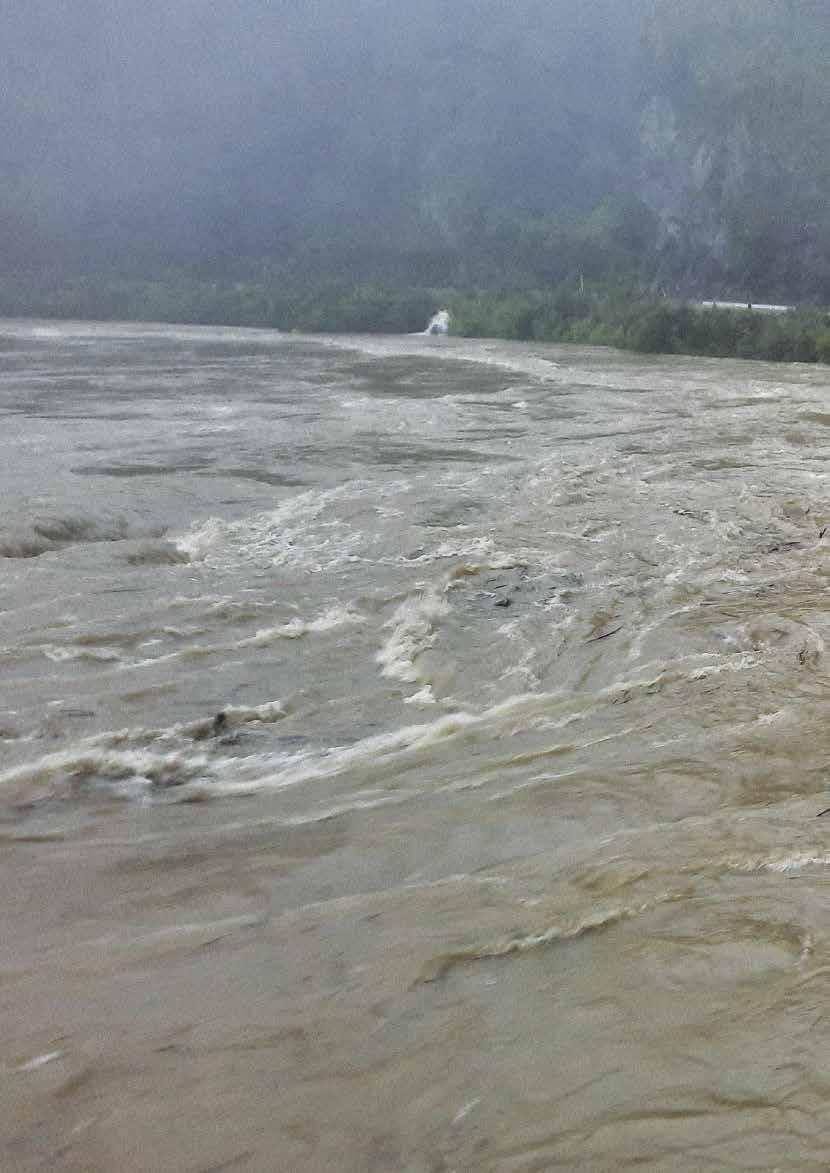
• 24/7 multi-hazard forecasting system
• Enhanced tools and guidance to help mitigate weather and climate hazard impacts
• Work with international partners to advance weather, climate and hazard forecasting
• Hydrological models to inform changes in water flows and storage Predict the effects of sea-level rise on coastal ecosystems and infrastructure
• Increase understanding of the effects of ocean acidification on ecosystems, including in Antarctica
Buller Gorge. [Geoff Mackley]

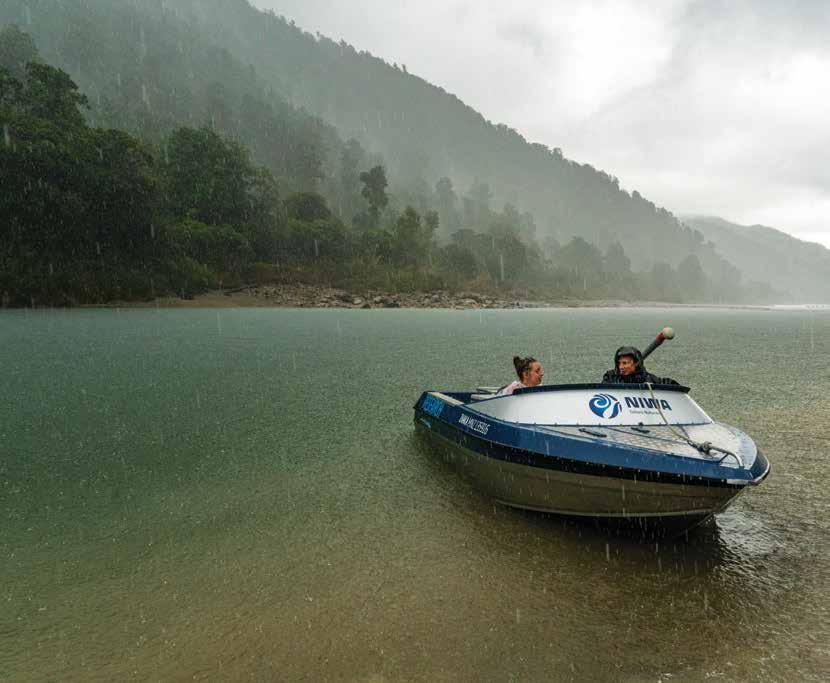
After a record-breaking flood devastated Westport when the Buller River broke its banks in July 2021, the region was hit by another deluge in August 2022.
NIWA has been working with the West Coast Regional Council since just before the 2021 event to develop a dedicated flood forecasting system. While the team wasn’t expecting the system to be put through its paces again so soon, once again it proved an invaluable information source to help emergency responders make decisions to keep people safe.
The system is underpinned by NIWA’s river flow forecasting tool and surface water flow model, which the research team is fine tuning for the West Coast region by updating the flood flow model for Buller and developing inundation scenarios. Strong relationships between NIWA and the council mean we can provide detailed flood, sea-level and wave forecasts as soon as heavy rain is predicted.
The project is funded by Kānoa – the MBIE regional Economic Development & Investment Unit, under the Infrastructure Reference Group funding, to enhance economic development opportunities in regional New Zealand.
As our climate changes, we expect storm systems to become more frequent and more severe. Science can’t stop it raining, but it can help communities prepare for the worst and plan for the future – and that’s just what the flood forecasting system for the West Coast is doing.

New Zealand could experience very long and very severe marine heatwaves, with analysis indicating an 80–100% increase by the end of the century under a high CO 2-emission scenario. New research by NIWA ocean modellers has shown that the impact of climate change means that what is now an intense marine heatwave scenario will start to become the norm. Marine heatwaves will accelerate the impacts of warming both at sea and on land. These include a reduced nutrient supply and a reduction in phytoplankton, a shift in the distribution of marine organisms towards Antarctica and into deeper water, and marine organisms adapted to warmer waters expanding their range into New Zealand waters. They will affect the fishing and aquaculture industries – warming seas have already negatively affected mussel and salmon farms.

Our modelling has been carried out using three emission scenarios, ranging from low emissions (the best-case scenario) to high emissions (the worst-case scenario). It has also shown substantial disparities between regions, with some coastal areas experiencing much more severe impacts. This regional assessment is possible because the high-resolution ocean grid in the New Zealand Earth System Model, developed by NIWA scientists as part of the Deep South National Science Challenge, allows us to differentiate between the regions.
 The intensity of marine heatwaves in present-day conditions (left) compared with the potential intensity in 2100 (right). [NIWA]
The intensity of marine heatwaves in present-day conditions (left) compared with the potential intensity in 2100 (right). [NIWA]

The Ross Ice Shelf – the world’s largest – is the floating southern boundary of the Ross Sea, and lies almost due south of New Zealand. Ice shelves play an important role, because they apply backwards pressure on the glaciers that feed them, acting as “brakes”. But when they warm up, this brake eases and more ice slides off the land and into the water, increasing sea levels and changing the Southern Ocean’s delicate ecosystem.
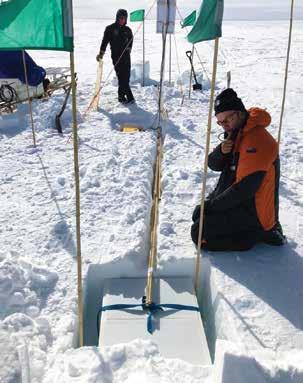
NIWA scientists, with their New Zealand and international colleagues, are working to piece together what is happening in the Ross Sea and the Ross Ice Shelf, and how they might be impacted by climate change.
Using a combination of radar technology, ocean instruments and float information, the researchers have been able to determine ice thickness, melt rates and the impacts on the water below. This information helps us simulate the impact on the ice shelves,
so we can better predict the implications of the warming climate on the shelves and sea level.
The team on the ice in January 2022 were also able to detect changes following the dramatic eruption of the Tonga volcano, Hunga Tonga–Hunga Ha’apai, as the tsunami generated by the eruption made its way through one of the ice cavities they were monitoring – an important reminder that our whole world is very much interconnected.
Nestled into the ice are radar units transmitting hourly data on ice-shelf thickness back to New Zealand every hour for more than a year via satellite, giving a real-time map of the melting rates from 12 sites. [Craig Stewart]
The Barne Glacier, which flows down from Mount Erebus, is one of the glaciers that feeds into the Ross Ice Shelf. [Natalie Robinson]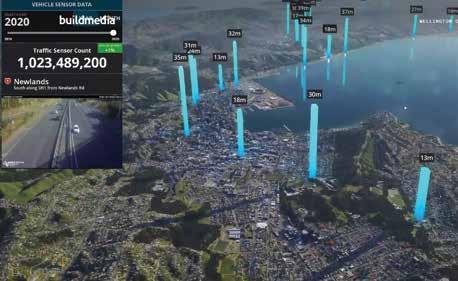
NIWA is working with Wellington City Council to visualise climate change and its consequences as part of a US$1 million ‘Digital Twin’ project. Wellington was one of just 15 cities worldwide selected from 631 applications. The project, funded by the Bloomberg Philanthropies’ Mayors Challenge, is designed to spark innovative and replicable ideas for improving cities and the lives of people living in them.

NIWA coastal and social scientists are contributing coastal modelling, coastal engineering and social science methodology to the project, which will be completed in
2025. When completed, the Digital Twin will be accessible through your digital device and through community facilities such as libraries. The code of the model will be open source, so others can use it and develop it further.
A virtual reality 3D visualisation will bring to life the science, data and hypothetical scenarios for climate change. Interactive maps will allow people to see what the Wellington coastline could look like in the future – for example, how will roads, buildings or coastlines be affected by different increases in sea-level rise?
 A mock-up of one of the 3D maps from the Digital Twin project, showing the Wellington waterfront and central city.
A mock-up of one of the 3D maps from the Digital Twin project, showing the Wellington waterfront and central city.
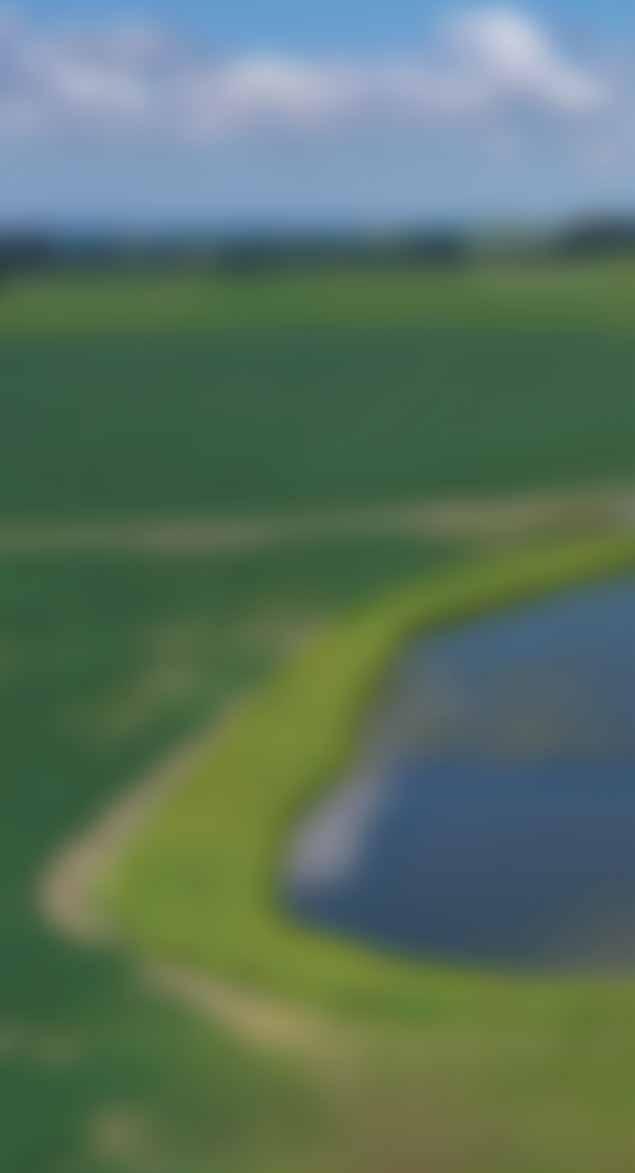

• Modelling tools to predict the impact of contaminants
• Contaminant mitigation systems Quantify the occurrence and distribution of microplastic
• Enhanced understanding of ecosystem processes and interactions
• Coupled models to link catchment land use and contaminant dispersion
• Models to predict degradation and potential recovery of aquatic ecosystems
• Measurements and forecasting to meet or exceed national and international standards
• Best practice data management, analysis, visualisation and accessibility
• Curation of internationally significant collections and samples
Tukipo, Central Hawke’s Bay. [Hawke’s Bay Regional Council]

Many rural wastewater treatment systems are failing, or do not meet desired cultural and freshwater objectives, such as those set out in the National Policy Statement for Freshwater Management. Conventional treatment upgrades are costly for smallscale treatment systems and require specialist operators, who are difficult to attract to rural towns.
NIWA’s Aquatic Pollution Group is midway through a five-year MBIE Endeavour Fund research programme to co-develop and mainstream a suite of innovative ecocultural wastewater treatment technologies for small rural and Māori communities.
The researchers are investigating options to transform wastewater into a resource by linking mātauranga Māori with scientific advances. Their investigations include trialling intensified multi-layered wetland filters, high-rate filamentous algae ponds, final effluent wetlands, accumulating volume sludge digestion ponds, and sludge treatment wetlands that convert wastewater sludge to soil.
A co-development team guides the project’s progress, working with marae, rural communities, industry and local government. The aim is to provide resilient, affordable, highly effective and culturally acceptable options to upgrade and operate rural wastewater treatment infrastructure that is future-proofed for population rise and the impacts of climate change.

Effective, efficient and affordable wastewater treatment for small communitiesA multi-layered constructed wetland treating wastewater at the Te Kopua Whanau Campground. [Chris Tanner]
NIWA’s research in Whangārei Harbour will help tangata whenua determine the challenges facing the harbour and inform decisions on where to target resources. [Jack Massuger]

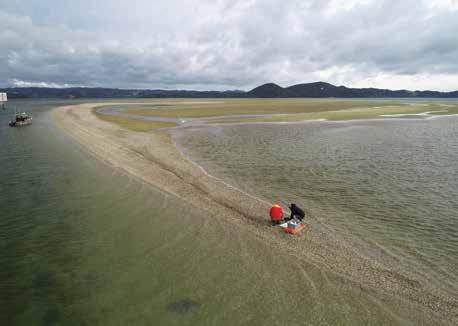
Working alongside Whangārei hapū Patuharakeke, NIWA is developing a Bayes net decision support tool for Whangārei Harbour/Whangārei Te Rerenga Parāroa. This tool determines the status of various ecosystem components, such as water clarity and shellfish abundance, depending on the stressors (fishing, sediment input) acting on the system. The tool is linked to another, developed by Patuharakeke, which describes the status of the harbour using a mana moana monitoring framework containing tohu (indicators) such as manaakitanga, whakapapa and mahinga mataitai.
The Bayes net decision support tool will enable tangata whenua, and managers, to understand the status of Whangārei Harbour under realistic future scenarios the harbour might face; for example, dredging, land-based inputs or fishing pressure. The unique aspect of the model is that it presents this status in different variables, such as ecological health, the abundance of kaimoana, or the overall mauri of the system. As such, this tool will empower smart decision making by identifying where best to allocate resources for maximum gain when it comes to monitoring, restoration and management intervention.
NIWA’s Māori Environmental Research team Te Kūwaha was engaged to help Maungaharuru-Tangitū Charitable Trust co-develop a cultural monitoring framework (called Tūtira Mauri Ora) and advise on a kaitiaki-driven monitoring programme for the Lake Tūtira catchment.


In the initial mid-2021 demonstration, a range of potential lakeside and instream methods that hapū kaitiaki can use safely and independently were tested. These values-based methods were chosen to support hapū kaitiaki assessments of three cultural values: tuna, swimming and kākahi. A refresher demonstration was held in mid-2022.
As the methodologies are embedded in the monitoring of the north-eastern Hawke’s Bay catchment, and as resulting datasets grow, hapū kaitiaki and Maungaharuru-Tangitū Charitable Trust will gain increasing confidence in the results to inform future decision making. Iwi members, including rangatahi and mokopuna, that took part in the instream and lakeside demonstration gained important taiao water monitoring skills and an awareness of what needs to be done to help improve the current environmental situation of the Lake Tūtira, Waikōpiro and Orakai catchments.
Above and Right: Maungaharuru-Tangitū hapū kaitiaki and NIWA staff testing the implementation of the Tūtira Mauri Ora Monitoring Action Plan in the Lake Tūtira, Waikōpiro and Orakai catchments. [Ngahuia Herangi]

Invasive marine species pose a threat to the health of the marine environment throughout the Pacific region, affecting livelihoods and quality of life of Pacific Island people. In response, NIWA researchers have developed new targeted resources to support Pacific marine biosecurity and invasive species management.

In March 2022, the Pacific Marine Biosecurity Toolkit was launched by the Secretariat of the Pacific Regional Environment Programme (SPREP) and NIWA, and it is available on SPREP’s Battler resource page. An online workshop launching the toolkit had 100 viewers watching live from more than 20 countries.
The toolkit provides a series of guidance documents to help tackle marine biosecurity issues and support government departments and ministries responsible for biosecurity and the management of invasive species. It also includes an inventory of invasive marine species, how they likely arrived and how they spread.
There are six elements to the toolkit that are aimed at providing guidance on many practical aspects of marine biosecurity. They include assessment tools on biofouling and ballast water risk, guides on the sampling of specimens and the top 25 global invaders, as well as management and mitigation strategies for when an unwanted species has established a self-sustaining population.
Yachts moored in a Fiji port. Vessel biofouling is the growth of plants, animals and other marine life on the surfaces of vessels, which is a major pathway for the spread of invasive marine species. The Pacific Marine Biosecurity Toolkit offers practical tools, including a biofouling assessment guide to support biosecurity management. [Kimberley Seaward]•
•
•

•
•
•

•
•
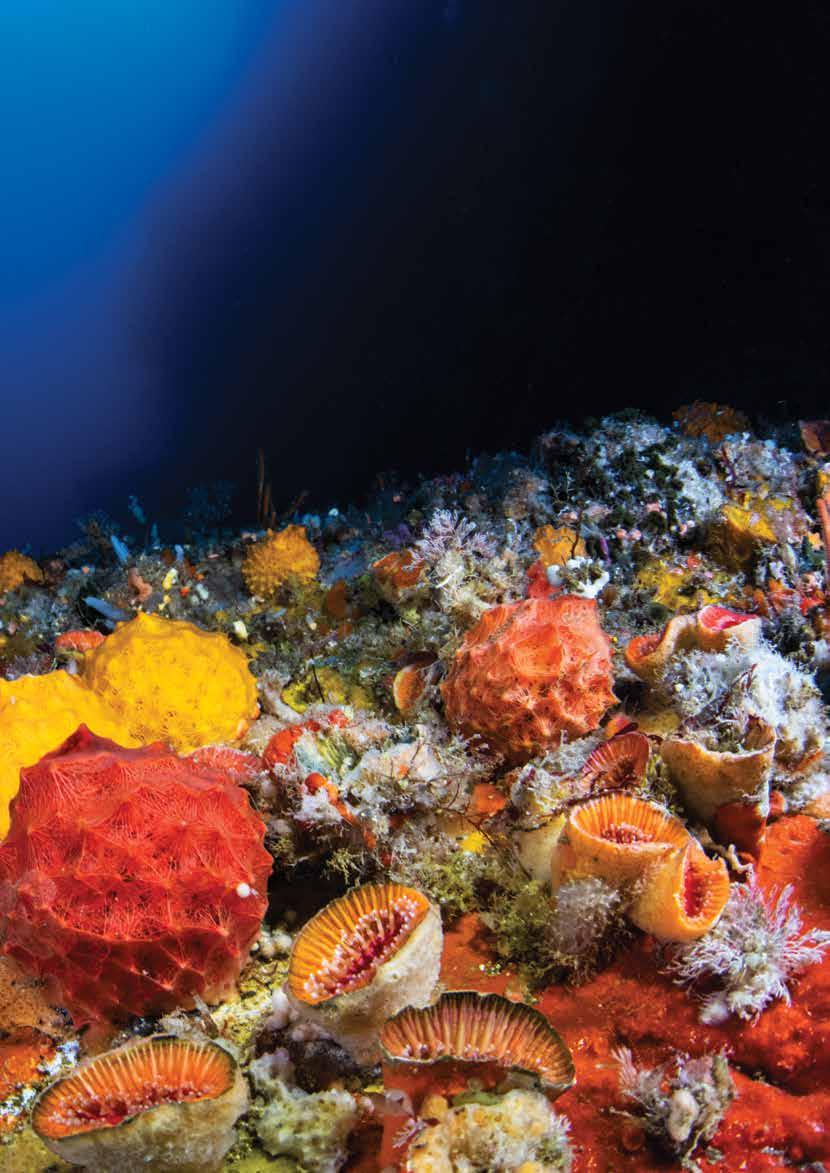
For the last 20 years, MPI has contracted NIWA to deliver the National Marine High Risk Site Surveillance programme every six months in 12 of New Zealand’s busiest shipping ports and marinas. Many of these sites are the first entry point for international vessels and where incursions by marine non-native species are most likely.
Divers Louis Olsen, Lily Pryor Rodgers and Andrew Miller prepare for a biosecurity survey dive in Bluff Harbour (Awarua). [Chris Wood]
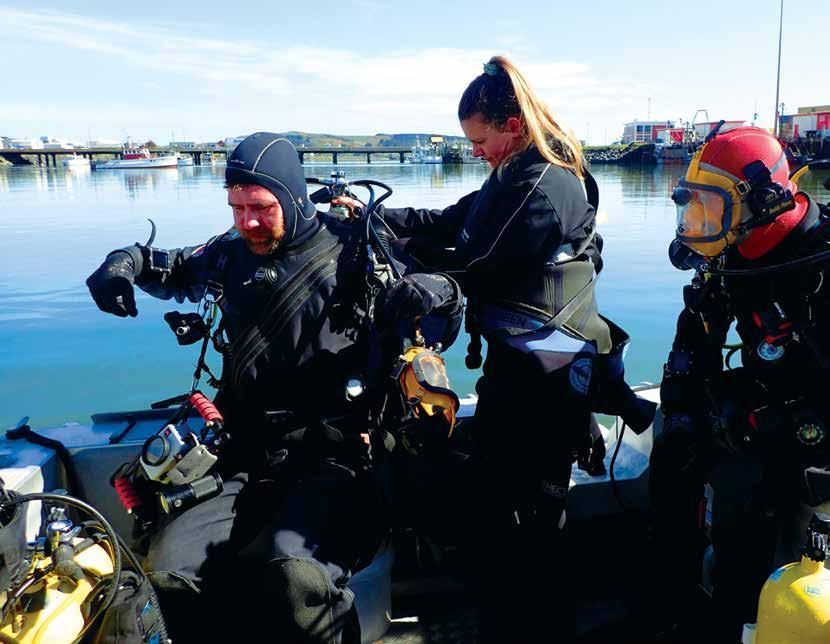
The surveillance aims to detect incursion of high-risk, non-native organisms – those listed on the national register of Unwanted Organisms or those that have not previously been recorded in New Zealand. It also detects range extensions by established organisms that exhibit characteristics of
pests. Sampling within each survey site is focused on the habitats and locations where target non-native species are most likely to occur.
Over the last two decades, the survey teams have completed 34 (biannual) rounds of surveys and sampled more than 90,000 locations for marine non-indigenous species. Their surveillance has detected 26 new-to-New Zealand marine species and 195 range extensions of marine nonnative species known to be in New Zealand waters. Some of these detections resulted in biosecurity responses from government agencies or regional authorities in attempts to delimit or eradicate pest species.
High-resolution mapping by NIWA, University of Auckland and Auckland University of Technology researchers has produced the first-ever global estimates of coastal habitat damage caused by anchoring.
The COVID-19 pandemic resulted in port congestion around the world, leading to unprecedented bottlenecks in maritime traffic and intensive anchoring of hightonnage ships – and seaborne trade is predicted to quadruple by 2050.
To understand how the increase of hightonnage ship anchoring will affect coastal marine ecosystems, the scientists combined information from high-resolution seafloor data, real-time ship tracking information,

Seafloor data from Wellington, collected in 2007 and 2008, showing increased seafloor roughness in the anchoring region. (The background satellite image was obtained from Toitū Te Whenua Land Information New Zealand (LINZ)). [NIWA]

scientific literature and news media. For the first time, they demonstrated that anchor damage on the seabed is severe, long-lasting and widespread, with the area of damage increasing with the number of ships, and the impact with the duration of anchoring.
In Picton, high-tonnage ship anchors excavate the seabed by up to 80 cm, displacing enough sediment to fill an Olympic-sized swimming pool, with impacts lasting for at least four years. Scaling these results worldwide suggests ship anchoring practices are a global driver of seabed damage, because the calculated volume of sediment displaced by a single high-tonnage ship on anchor can reach a volume of 2800 m3
Anchors cause extensive and persistent damage to the seafloor
Over the last decade Ngā Kaitiaki o Ngā Wai Māori (NKoNWM) have been working with Northpower, NIWA, the Ministry of Primary Industries, the Department of Conservation and other agencies to move juvenile eels (elvers) over the Wairua Falls Power Station as they swim upstream during part of their life cycle.
To test the success of the trap and transfer programme, each autumn NKoNWM and NIWA investigate how the elvers that were moved over the power station are surviving. The annual survey involves catching juvenile eels in streams connected to the Wairua River to assess their numbers and distribution. The eels are identified by species, measured and then promptly returned to the stream.
The survey is one of many projects within the Cultural Keystone Species research programme, where mana whenua undertake the fundamental research required to inform their unique responsibilities as kaitiaki.

Before the Wairua River elver surveys began, very little research had been undertaken nationally to help explain what makes stream habitats suitable for elvers to thrive. This multi-year survey has significantly improved understanding of the factors that affect the survival of juvenile eels and what habitats are good for tuna.

NIWA staff and members of the seven hapū of NKoNWM search for tuna by use of electric fishing. The tuna are returned unharmed to the stream after the assessment. [Rebekah Parsons-King]

The Cultural Keystone Species was a four-year (2016–21) MBIE-funded research programme that built on the freshwater taonga species research that NIWA has been undertaking with whānau, hapū and iwi around the country over previous decades.

The programme included interlinked studies centred around understanding what causes stress to freshwater taonga species throughout their life. It has co-developed research methods, tools and products with whānau, hapū and iwi that inform new and innovative management approaches for the protection, restoration and economic development of taonga species such as tuna, kōura and kākahi. These include significant advances in understanding the water quality and habitat needs of juvenile tuna, kōura and kākahi, and new methods for understanding the state and trends in populations that are directed by mātauranga Māori and informed by hapū-driven datasets.
The programme supported at least 30 researchers working in partnership with 20 hapū/tribal entities, seven consultancies, two power companies and 15 regional and central government agencies. In collaboration with the University of Waikato, the Cultural Keystone Species team also supported five graduate students and three summer research scholarship interns through a variety of practical experiences, including developing strong professional networks and gaining an understanding of the importance of partnerships between hapū/iwi, agencies and research providers.
Freshwater species such as tuna, kōura and kākahi are central to the identity and wellbeing of many Māori communities throughout New Zealand. [Stuart Mackay]
The judges described this as a cool, fun environmental portrait with clever use of torchlight. They noted Jon’s grin as a good juxtaposition to the contrasting steel chamber of the ship.
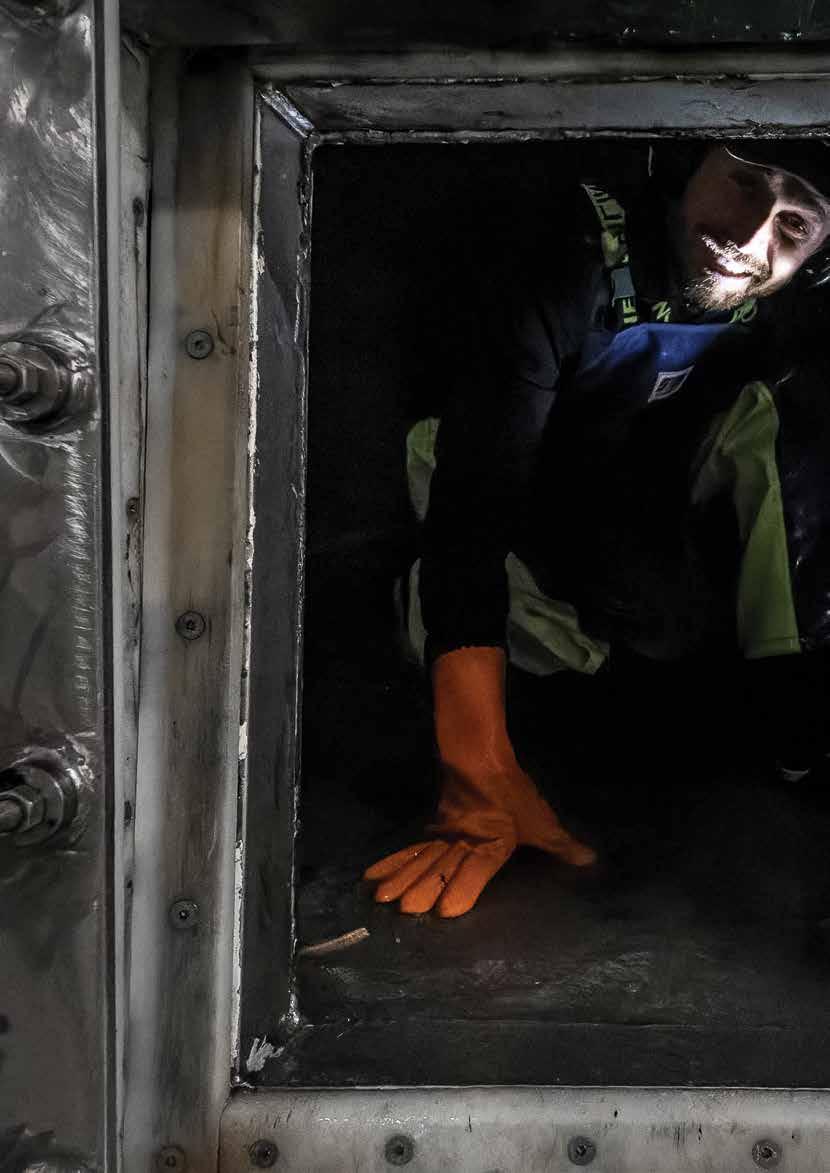 Rikki Taylor
Rikki Taylor

At the forefront of national and international scientific enquiry, delivery and innovation, our people are the key to answering some of the most pressing issues of our time.
Continuing our full commitment to health and safety
Health and safety remains a top priority, with a focus on ongoing continuous improvement building on the fundamentals of our health and safety management system.
During the year there was a significant need to respond and adapt to emerging business needs in the changing COVID-19 requirements. We also refreshed our project health and safety plans and created a visual dashboard of incidents to further improve root cause trend analysis.
Fieldworker safety was enhanced by additional satellite-enabled field communication devices, and working with a third-party, real-time, tracking and communication platform, and integrating it with ‘Trip Planner’ – our online emergency notification tool – enabled a nationwide view of fieldworker locations and intentions.

Over the course of the year, 10 new permanent positions were approved to meet the demand for our scientific services and the required support. Retention remained strong, despite increasing competition for skilled talent.
We apply best practice principles and methods during our recruitment and selection, with a thorough selection process being undertaken for all appointments. New staff receive an in-depth induction covering generic and job-specific information to provide a supportive and welcoming experience. A 3-month post-entry interview checks on early experiences to ensure new staff are well-settled. We also continually review the induction process to ensure its relevance, quality and consistency.
Ensuring positive employment relations, engagement and collaboration
We are committed to the good employer requirements of Section 118 of the Crown Entities Act 2004, and our People & Capability practices and policies are consistent with the fair and proper treatment of staff in all aspects of their employment.
Engagement between management, employees and employee representatives regarding workplace practices and policies is ongoing. Early in 2022 Executive Team members met staff at each of our main sites to reconnect after the COVID-19-related travel restrictions, provide an update on key organisational priorities and objectives and engage with staff on topical issues. Our property development programme continues to provide an opportunity for staff engagement to facilitate ongoing constructive partnership on this multi-year project.
A NIWA-PSA Pay Equity Working Group was established to share perspectives and ideas on gender and ethnic pay equity within NIWA, consistent with the government’s Kia Toipoto action plan.
A southeasterly and temperatures of 2 degrees failed to deter 21 NIWA Wellington staff leaping into the harbour to mark the midwinter solstice on 20 June. [Mia Blyth]

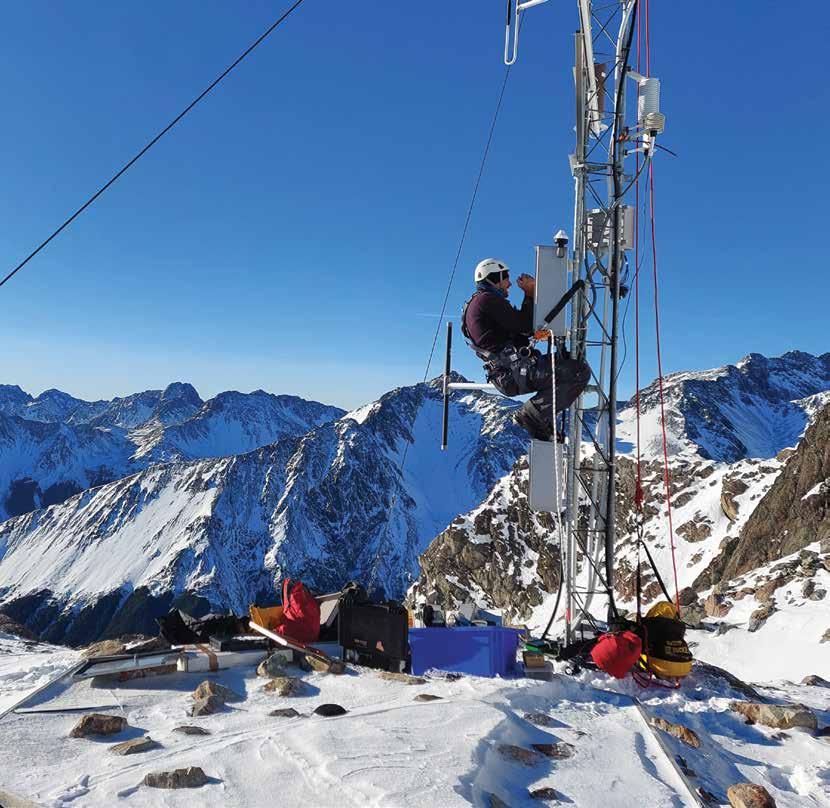
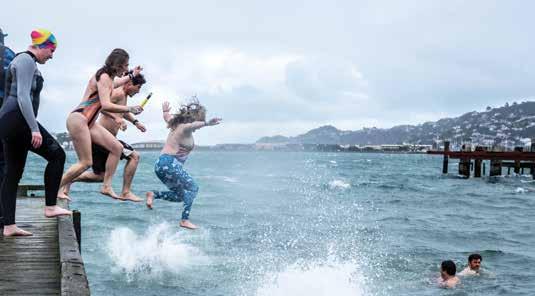

Our annual workforce planning process considers capability and capacity requirements for our science and support staff in light of market and workforce dynamics. Succession plans are reviewed, and talent acquisition and transition plans are established in relation to staff signalling departure. High-potential and high-performing staff are identified, along with those requiring additional support to lift their performance to required levels. This sets the broader context for annual Performance and Development Reviews and half-year Progress Reviews, where managers and team members come together to review performance and development objectives, agree new objectives, discuss accomplishments and consider career development aspects.
We prioritise investment in continual professional development of our highly skilled and educated workforce. A range of in-house leadership and management workshops are offered annually, including Recruitment & Selection, Developing Others, Crucial Conversations, Personal Effectiveness, Mental Health Awareness, and Challenge of Change – Resilience. A variety of other seminars and workshops are also offered across the regions. Most staff receive three personal development leave days per year to undertake activities to enhance their wellbeing and broader personal development.
The Senior Leadership Development Programme is now in its second year. Our focus includes personal effectiveness, coaching, emotional intelligence, strategic thinking and bicultural competency. Participants in the 3-year programme experience psychometric assessment, 360 degree feedback, peer coaching, mentoring from senior leaders, action learning opportunities, and discussions of contemporary leadership literature. A new cohort of 12 leaders began their programme in February 2022.
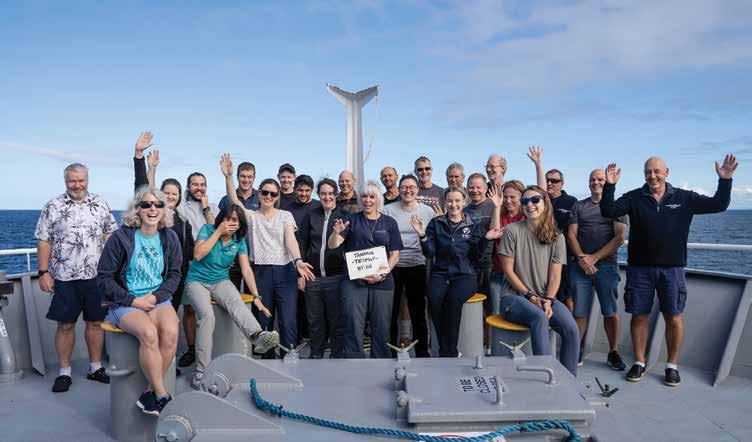
In addition to work in previous years aimed at improving awareness of our existing policies, guidelines, and practices, we developed an Understanding Gender Dynamics in the Workplace training module for managers to underpin the principles of fairness, equity and non-discrimination in employment. This supports an online training course on Unconscious Bias we offer to all staff through the Digital Learning Hub, which has been refreshed and expanded to five modules.
The NIWA-Nippon Foundation Tonga Eruption Seabed Mapping Project team comprised marine biologists, biochemists, geologists, technicians and students, pictured here with Tangaroa crew members on the transit home to Wellington from Tonga. [NIWA-Nippon Foundation TESMaP/Rebekah Parsons-King]In the spirit of maintaining a constructive and professional working environment, we continue to train staff as contact people to support our Unacceptable Behaviour Policy & Resolution Process, to be available as a first point of contact if others require assistance. We remain committed to improving awareness of family violence and ensuring staff who may be impacted by family violence are safe and supported in the workplace, providing training for contact people and managers, and promoting access to SHINE, a specialist family violence support organisation.
We provide a family-friendly workplace, with flexible start and finish times, part-time working arrangements, and opportunities for hybrid working arrangements, where appropriate, on a case-by-case basis to help staff balance personal and work commitments.
We continued to prioritise employee wellbeing in another year marked by ongoing adaptation to the COVID-19 pandemic. Managers are the primary point of connection and support for staff – helping their teams bolster resilience, identifying and mitigating risks, and connecting staff who need support with appropriate services. During the 2021 lockdown a single-page guide and a ‘Korero Cards’ resource was developed to help managers have conversations about wellbeing during virtual meetings, and a ‘random coffee catch-ups’ initiative promoted conversations and connections across the wider organisation.
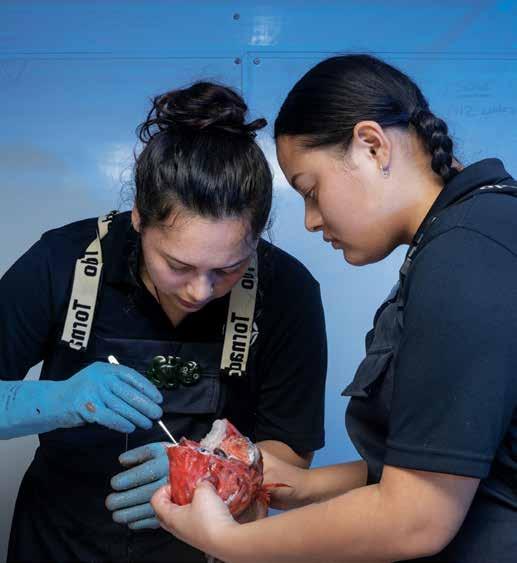
The simple scene of dosinia shells on the beach in Mount Maunganui was turned into something striking and dramatic with the clever use of the low angle shot, which the judges said created an exaggerated perspective and deep sharpness.
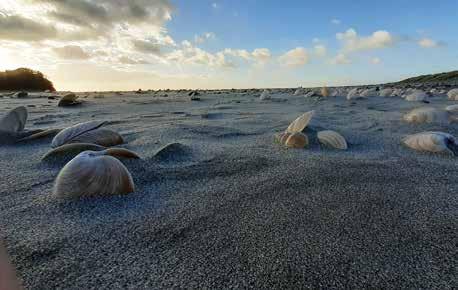 Kararaina Te Puni and Melanie Mayall-Nahi started their careers at NIWA as part of our Te Kūwaha graduate programme. [Rebekah Parsons-King]
Kararaina Te Puni and Melanie Mayall-Nahi started their careers at NIWA as part of our Te Kūwaha graduate programme. [Rebekah Parsons-King]
From a physical wellbeing standpoint, we offer opportunities including workstation assessments, free on-site skin checks, manual handling training and flu vaccinations for all staff. The People & Capability team continue to maintain the intranet Wellness Hub with a range of physical, mental, financial and social wellness resources.
Recognising, rewarding and celebrating our people This year we celebrated 32 science level promotions, which follow a comprehensive peer review process and represent years of practical application and knowledge development. Our remuneration framework includes regular internal and external benchmarking to ensure staff are fairly remunerated. We continue to apply the Living Wage as the minimum across the organisation.
The annual NIWA Excellence Awards recognise outstanding performance across 12 categories, and the annual staff photography competition has 6 award categories.

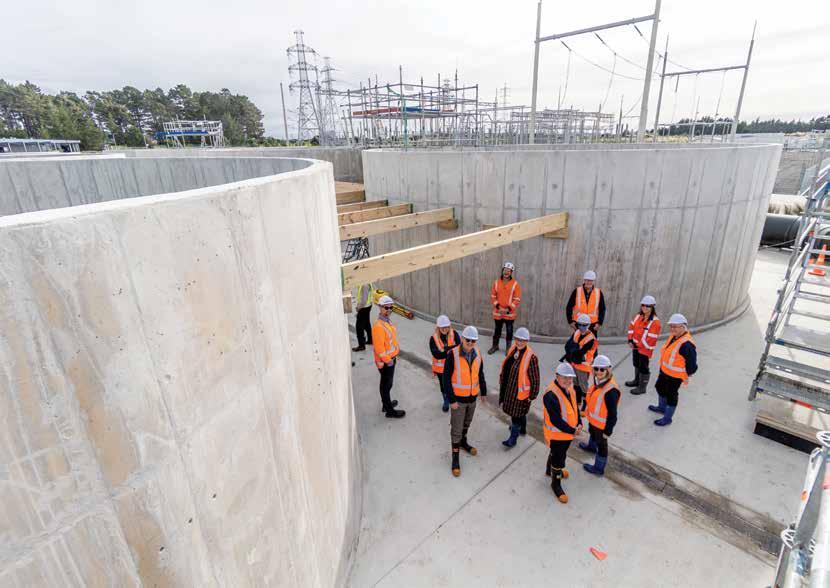
We maintain a lead role in online national and international conferences, workshops and working groups. Staff showcased NIWA expertise and collaboration, held chairing roles, presented keynote addressess and contributed to international councils and advisory groups – with about 220 staff attending 51 international and 46 domestic conferences. Fourteen staff attended international forums in person in the later months of the financial year.
In addition, more than 100 scientific workshops were run or attended by NIWA staff, including research and strategy co-development with stakeholders, education and training, project partnership, and knowledge and tool-sharing. Workshops were held with local and central government agencies, utility companies, iwi/hāpu, Pacific Island entities, conservation agencies, consultancies, commercial clients, other Crown Research Institutes, sub-contractors,
General Manager, Science Dr Rob Murdoch speaking at the post-voyage media conference for The NIWA-Nippon Foundation Tonga Eruption Seabed Mapping Project, which was livestreamed and simultaneously translated in Japanese. [Rebekah Parsons-King]Members of NIWA’s Board and Executive inspecting the recirculating aquaculture tanks under construction at the Northland Aquaculture Centre.
[Lana Young]farming, dairy and irrigation industry groups, and international and United Nations parties.

Our people held a range of key advisory roles and secondments, including seven staff seconded to government agencies and stakeholders. We supervised 67 PhD, 28 Masters and 4 Bachelor students nationwide (many hosted on our sites), and financially supported 4 postdoctoral and 15 PhD positions. Trainees from the Pacific Islands and other countries were hosted and trained via virtual workshops, and a range of science visitors, interns and students were also hosted, including four Te Kūwaha interns and five BLAKE Ambassadors working on science projects alongside NIWA staff.
Seven staff held appointments with New Zealand universities (five with the University of Auckland, one with the University of Otago and one with Victoria University of Wellington) and many others hold adjunct roles.
We continue to support the major school science and technology fairs in Auckland, North Harbour, South and East Auckland, Waikato, Bay of Plenty, Wellington and Canterbury-Westland, as well as eight regional fairs, through sponsorship, promotion and staff involvement in judging and award ceremonies.
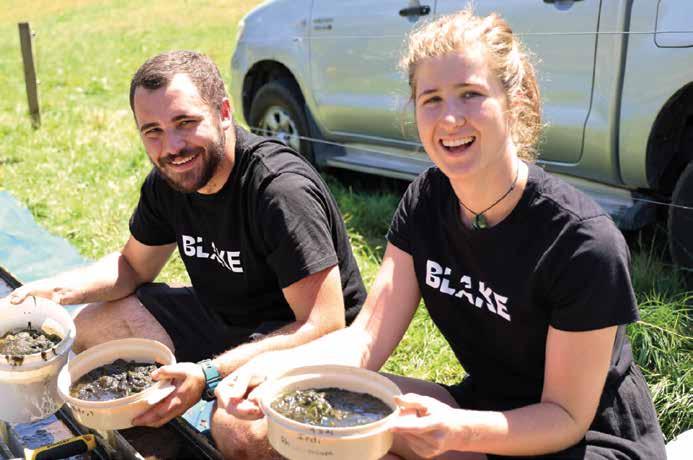
Our Work Award Winner – Irene Middleton This image of red rock lobsters congregating below black coral was taken in Doubtful Sound, Fiordland. The judges enjoyed the great use of colour and the attitude of the crayfish – looking like they were ready to defend their rock from inquisitive photographers.


Ryan’s vision and perspective gained from his research and stakeholder engagement has been crucial in the development of RiskScape – world-leading, open-access, multi-hazard, risk modelling software.
He has promoted RiskScape among councils, industry, researchers and other stakeholders, achieving excellent market penetration within the hazard and risk sector nationally and internationally.
Ryan has provided strategic leadership and analytical prowess for both RiskScape and PARTneR (RiskScape Pacific) projects, successfully led the joint venture upgrade to RiskScape II and trained more than 100 students and practitioners in its use.

Drew is a leading practitioner in historic and palaeoclimatology research. His work has greatly enhanced our understanding of New Zealand and Southwest Pacific past climate variability. He leads projects across multiple areas, including understanding past climate from swamp kauri and coral, rescuing old weather observations, developing methodologies for better tropical cyclone outlooks, and monitoring and understanding changes to glaciers.
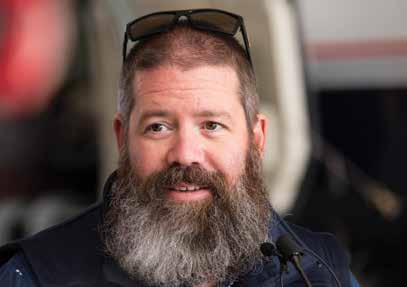
Drew is widely published in prestigious journals, being lead or co-author of more than 50 articles, has strong international collaborations, is an excellent science communicator and a passionate mentor of young scientists.
Deb’s impressive organisational skills, her excellent people management and the attention she paid to communication ensured the successful completion of a Smart Idea project on freshwater bioremediation using freshwater mussels. The project involved a large multi-disciplinary team with multiple work strands, half of which were conducted during the COVID-19 pandemic.
Deb created an effective collaboration within the diverse project team, earning their respect by communicating well through regular updates and involving community representatives wherever possible.

Kieran’s operational innovation has been critical in helping ensure staff are safe when working in the field. His expert IT assistance in improving our emergency response procedures led to a nationwide view of field team locations.
Kieran was involved in developing the scope, selecting and interviewing responders, deploying new devices, user training and integrating Trip Planner with the system of the chosen provider – resulting in a very successful roll out of new equipment and procedures.
Katie has a growing international reputation as a submarine canyon expert, and in only three years at NIWA, has already been awarded well over $1 million in contestable funding.

She led three successful Tangaroa voyages this year, during challenging COVID-19 conditions, and has already published 30 papers. In addition to project management and leadership of voyages, publications/reports and proposals, she also took on the role of Group Manager Ocean Geology in March this year.
Kevin has displayed exemplary leadership both nationally and internationally in geospatial and bathymetric communities for years, and was the voyage leader for the month-long Tangaroa expedition of the Nippon Foundation-funded Tonga Eruption Seabed Mapping Project, to study the effects of the Hunga Tonga–Hunga Ha’apai eruption.
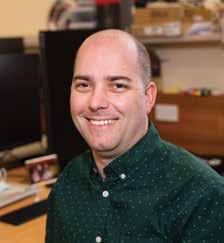
Kevin is also the Centre head of the South and West Pacific Regional Centre of Seabed 2030, a project which aims to map the world’s ocean floor by 2030.

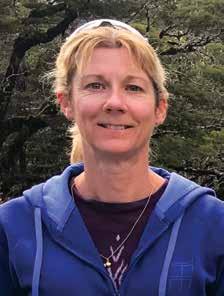
Cindy has demonstrated exceptional customer focus with her leadership of a nationally significant environmental study required for the re-consenting of the Wairakei Geothermal Power Scheme. The scope and quality of the investigation were exceptional, helping the project move smoothly through the consenting process.
Cindy’s focus on developing collaborative relationships with iwi and willingness to engage and incorporate mana whenua resulted in a positive working relationship between NIWA, the client and iwi. Delivering on time, to budget and within scope, while keeping the client well informed, has led to another large contract.
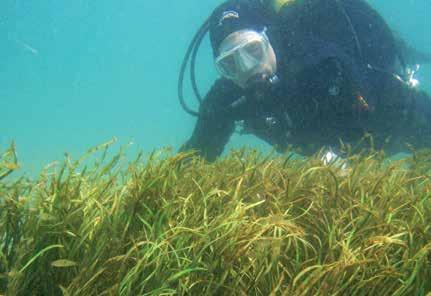
Natalie has promoted Antarctic science to the world. She is one of New Zealand’s best-known Antarctic researchers, and her passion for her work combined with her thoughtful, considered manner makes her an inspiring communicator.
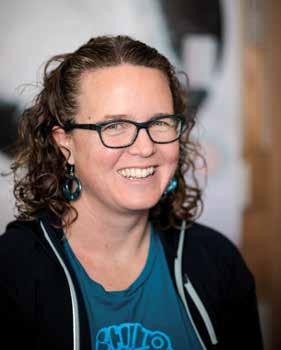

She was selected by Forbes magazine for Seven Outstanding Women in STEM, appeared on Sesame Street, featured on a New Zealand postage stamp and was invited for a private audience with the Prime Minister. She also initiated the annual Wellington Antarctic Family Days and regularly works with multi-school science projects.
Matt is one of the Auckland Health and Safety Representatives and has spent many years advising the vehicle Critical Response Team from its first inception. He is the Auckland Boat Manager, has been part of the Auckland dive team and is an active Principal Technician. He has excellent boating skills, safety protocols and first aid. Matt’s 20+ years of experience and genuine concern for safety on the water and the road helps get his team home safely at the end of each day. He is a cornerstone of the Auckland Safety team.
Alex is a key connector, translator, conduit and deliverer within the Te Kūwaha National Centre. She has embraced every opportunity to strengthen the cultural competency of the NIWA communications team, working with the Te Kūwaha team and for the benefit of our iwi/hapū partnerships.
Alex proactively leads and contributes to communications initiatives for the benefit of hapū, iwi, kura and Māori businesses. She has enabled Te Kūwaha to explore and realise new innovations and communication formats which have significantly increased NIWA’s national profile with a wide range of Māori audiences.
Kath combines excellence in her role as a People & Capability Manager with an optimistic approach and an ability to build genuine relationships. Her counsel and assistance are sought and appreciated by all who benefit from her knowledge and her ability to proactively identify issues and find solutions.
Kath will raise differing views to ensure the best outcomes for all parties. She is an excellent mentor, has profound analytical skills and is generous with her time, explanations and support.

National Marine High Risk Site Surveillance Field Team Leaders – Dane Buckthought, Megan Carter, Louis Olsen, Lily Pryor Rodgers, Kimberley Seaward, Matt Smith
Twice a year, teams of NIWA divers survey 12 major ports and marinas to enable early detection of unwanted, non-indigenous species, providing a chance of eradicating or managing them. These surveys are a critical component of Biosecurity New Zealand’s work to protect our ecosystems, economy and cultural/societal values.

Done while vessels are loading/unloading, and often in challenging weather and sea conditions, the surveys are time-sensitive, complex and high-risk. The Field Team Leaders have ensured consistent, high-quality delivery of this programme for 20 years, and in 2021 this internationally recognised programme was successfully re-contracted for a further three years.
When the nation was forced into lockdown during the initial phases of the COVID-19 pandemic, we all picked up our laptops and perhaps a screen and a chair and headed home. In short order, we were operating remotely and effectively.
Gordon didn’t quite follow that prescription. He did take his laptop, but he also took enough equipment from the gas lab to set up a lab in his garage, enabling him to monitor local levels of carbon dioxide, carbon monoxide and methane.
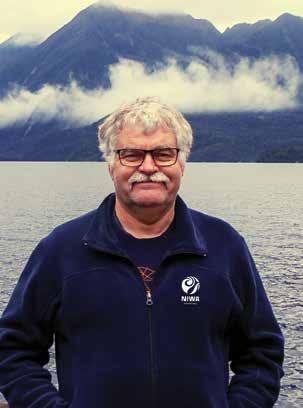
Gordon characterises long-term observation of greenhouse gases with his 35 years at NIWA. He leads the measurement of greenhouse gases in New Zealand at Baring Head, Lauder and Maunga Kākaramea, and in Antarctica at Arrival Heights. All of which contribute to the WMO Global Atmosphere Watch programme reporting data to the World Data Centre for Greenhouse Gases.
He has authored nearly 50 journal papers, presents frequently at national and international conferences, and is an extraordinary, imaginative and passionate science communicator. Articulate, thoughtful and entertaining, he is generous with his time and adapts his explanations to his audiences, whether they’re primary school children, Baring Head open day visitors or research colleagues.
Joshu Mountjoy was recognised with the Geoscience Society of New Zealand’s premier research award, the McKay Hammer Award, for his work on seafloor earthquakes and canyons. Joshu and his team recorded, for the first time, a process that causes the development of deepsea canyons.


Fisheries scientist Di Tracey’s advocacy and mentoring of women in science was acknowledged with the Association for Women in Science 2021 Miriam Dell Award. Di has supervised Masters and PhD students and ensured women in the workplace are encouraged and supported into senior roles.
Principal scientist for river and coastal geomorphology, Murray Hicks won the New Zealand Hydrological Society 2021 Outstanding Achievement Award. The honour recognises Murray’s career-long contribution to hydrological science and water resource management.
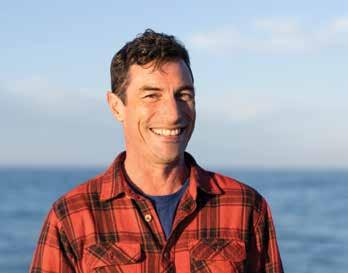

Geomorphologist Jo Hoyle won the Rivers Group Wahine Toa Award. The award, in its inaugural year, recognises Jo’s work as a true multidisciplinary river specialist, a role model and one of the few practising geomorphologists in New Zealand.
Dr Amir Pirooz
University of Auckland, Best Doctoral Thesis
Modeller and analyst, Amir Pirooz was awarded a 2021 Best Doctoral Thesis Prize by the University of Auckland for his “Extreme Winds in New Zealand”. A specialist in numerical weather prediction and computational fluid dynamics, his thesis contributed significant improvements to New Zealand’s wind loading standards.
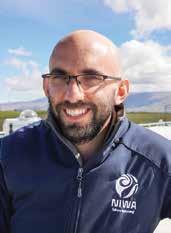

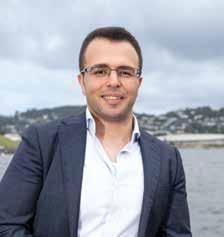
NIWA fisheries, atmospheric, climate and meteorological scientists were honoured at the 2021 Science New Zealand Awards. Atmospheric scientist Dr Alex Geddes won Early Career Researcher for his role in the CarbonWatch NZ and MethaneSat research programmes. Principal Scientist Fisheries Dr Malcolm Clark received the Lifetime Achievement Award for his internationally-recognised fisheries management and South Pacific seamount research. The Team Award was won by the Forecasting Team, for their work from detailed daily back-country forecasts for the Department of Conservation through to hazard warning for councils and emergency services, along with customised forecasts for events such as the America’s Cup.

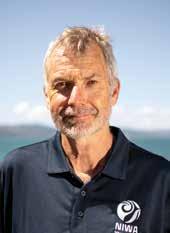
Ian Longley won the Clean Air Society of Australia and New Zealand’s Clean Air Achievement Award for his ongoing air quality research. The award recognised Ian’s research programme which touches on all aspects of urban air pollutant emissions and particularly his work communicating air quality monitoring and management to the masses.
Dr Alex Geddes Early Career ResearcherA wētā clambers across the Northland forest floor Special Award Winner - Crispin Middleton The drama of this wētā menacingly crawling towards the viewer made it a favourite of the judges. They described it as having sharpness where it mattered, an exquisitely subtle background and great composition.


Scientists 38.3%
Technicians 36.7%
Support 18.6%
Operational support 6.4%
Doctoral degree 30.9%
Master’s degree 17.5%
Bachelor’s level* 29.8% Other 20.3%
No qualification 1.5%
* Includes Graduate Certificates and Diplomas, Bachelor’s (Honours) and Postgraduate Certificates and Diplomas.
European 84.6%
Asian 8.7%
Māori 5.8%
MELAA 2.6% (Middle Eastern/Latin American/African)
Pacific Peoples 1.4% Other 3.3%
* Some employees identified with more than one ethnicity and some did not provide this voluntary information.
The percentages represented are based on all ethnicities reported.
AGE
20–29 9%
of NIWA staff identified that they have a form of disability
Female 40.6%
Male 59.3% Non-specific 0.1%


At 5.30am on a windy Wairarapa day, the fiery colours of the sky reflecting on the beach caught Gregor’s eye. The public loved this picture too, voting it their favourite in an online competition, and Gregor’s chosen charity the Kea Conservation Trust has benefited from his $1,000 win.
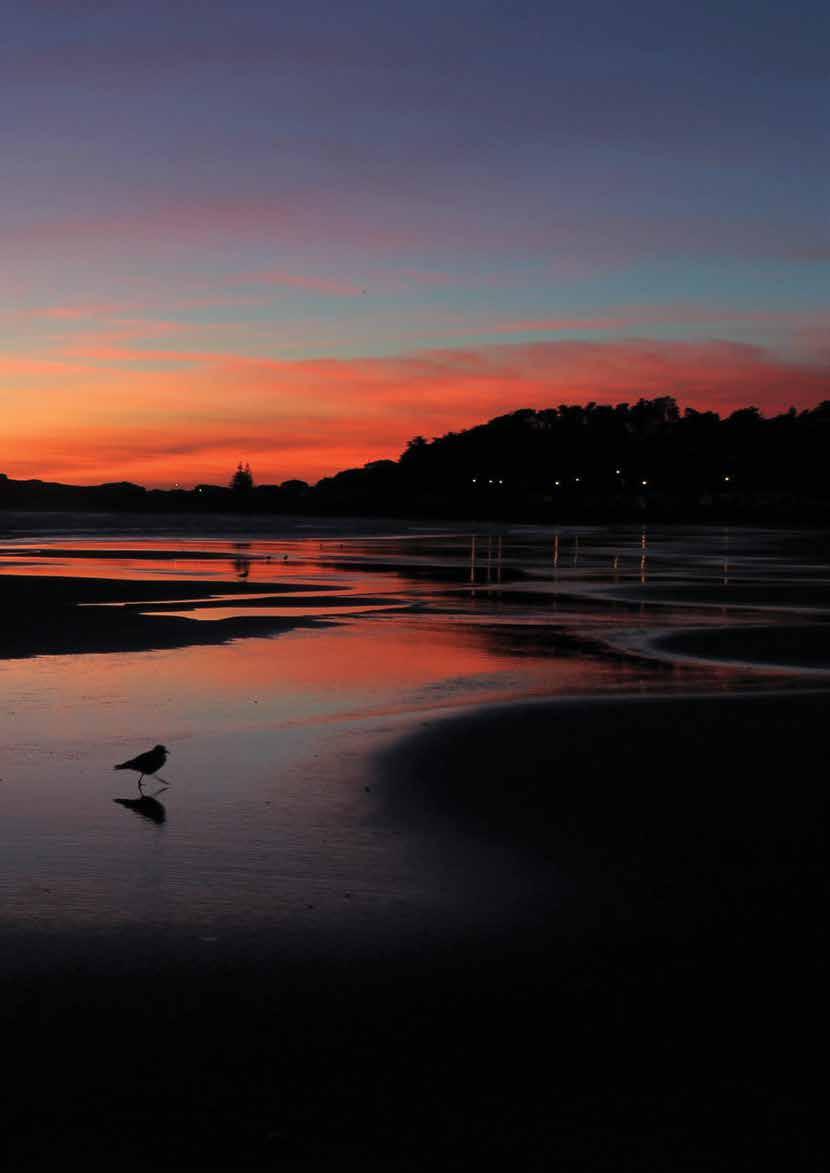
Barry Harris is a company director with extensive governance and executive experience.


Barry has held a number of chief executive roles including Environment Waikato, Greater Wellington Regional Council and Hamilton City Council. He was also a senior executive with Fonterra for five years. Barry currently chairs Food Innovation Waikato, OSPRI , McFall Fuel, Hamilton Airport Company and Wel Networks. He is also a member of the Waikato River Authority. Previous boards include DairyNZ, Primary ITO, CentrePort, RD1, AgResearch, International Nutritionals, Hamilton Riverside Hotels and Local Authority Shared Services.
Barry has a Masters of Agricultural Science (Honours). He was appointed Chairman of NIWA in July 2018.
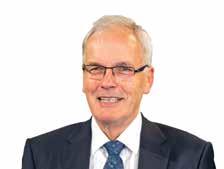

Nick is a fellow of Chartered Accountants Australia & New Zealand and for over 35 years built a career in the auditing and accounting profession in the United Kingdom and New Zealand. He became Chief Executive and later Chairman of Deloitte in New Zealand and Chair of the New Zealand Business Council for Sustainable Development. More recently, he was Deloitte’s Global Managing Partner of Sustainability and Climate Change Services and Global Chief Sustainability Officer, based in London. He has also served as Deloitte’s Global Chief Ethics Officer. Nick is currently a member of the board of The Sir Peter Blake Trust.

Mary-Anne is a professional director and also provides strategic advice principally into local and central government agencies. She is a director of The Environmental Protection Authority, DairyNZ, AgResearch, Fire and Emergency New Zealand and on the University of Waikato Council. Mary-Anne is a former Chief Executive of the Bay of Plenty Regional Council and has held senior roles in the Ministry for the Environment. She worked internationally in multi-national environmental and engineering companies where she specialised in environmental management providing advice across a range of sectors including the oil industry, high tech and heavy industrial manufacturing, the nuclear industry, water and waste management and the mining industry. She has a Master of Science (Hons) in Earth Sciences and Geography.
Dean has held various director and senior management roles in Aotearoa’s food and seafood sectors. He was Managing Director and CEO of Prepack Ltd and previously held Chief Executive and General Manager roles within Aotearoa Fisheries Group, New Zealand’s largest Māori-owned fisheries company. He is a director of Plant & Food Research and AsureQuality, as well as serving on the board for Akaroa Salmon NZ and Port Nicholson Fisheries. Of Ngāti Porou and Apanui descent, Dean is also a Director of Te Runanganui o Ngāti Porou, and its commercial entity Ngāti Porou Holdings Ltd. He is a Fellow Chartered Accountant, has a BCA from Victoria University and has worked in audit and business advisory for Ernst & Young.

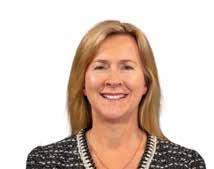
Tracey is an experienced non-executive director who currently serves on the boards of EBOS Group Limited, Medibank Private Limited and the Accident Compensation Corporation, where she is Deputy Chair. During her executive career she was Group Chief Executive of Imperial College Healthcare NHS Trust in the United Kingdom, Group CEO of St Vincent’s Health Australia and CEO of a number of other healthcare groups in Australia. Tracey is a qualified medical practitioner and holds a Master of Business Administration from Harvard University. She is a Fellow of the Australian Institute of Company Directors and a Chartered member of the New Zealand Institute of Directors.
Janice is a professional director with over 20 years’ governance experience. She has a broad portfolio of current and past directorships with significant experience in commercial, public sector and not-forprofit sectors. She is currently Chair of the Civil Aviation Authority and the Aviation Security Service, a director of Mainpower NZ Limited, Mt Cass Windfarm, Unity Credit Union, Ministerial Appointee to the Lincoln University Council, an independent member of the Timaru District Council Audit and Risk Committee, and a trustee of the NZ Shipwreck Welfare Trust. Janice has held senior executive positions in the professional services sector and the finance and banking sectors both in New Zealand and internationally. She is a Chartered Fellow of the Institute of Directors and a Chartered Accountant. She has a Bachelor of Commerce and a Master of Business Administration.

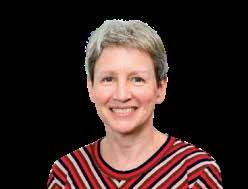
Originally from Canada, Margaret holds a PhD from the University of Western Ontario and has spent her research career specialising in aluminium technology, and the chemistry and engineering of material surfaces. She is a Fellow of the Institute of Chemical Engineering and a Fellow of the Royal Society of New Zealand. She is currently Vice-Provost (Research) at Victoria University of Wellington. Margaret has extensive national and international research connections. She was the inaugural Director of the Science for Technological Innovation National Science Challenge. In 2017 she was seconded to the New Zealand Ministry of Business, Innovation and Employment as Chief Scientist. Margaret is an independent director of Cirrus Materials Science, Deputy Chair of Wellington UniVentures, and a trustee of the Karori Sanctuary Trust (Zealandia Te Māra a Tāne).


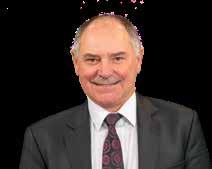
John joined NIWA as CEO in April 2007. He has extensive senior executive and governance experience in public and private sector organisations covering a range of markets and activities, including business, science, education and sport. His science sector roles have included Chairman of Science New Zealand, CEO of AgriQuality Ltd, Executive Director of Orica New Zealand Ltd, and Chairman of New Zealand Pharmaceuticals Ltd. John is passionate about the role science can play in transforming New Zealand’s economy, environment, society and global reputation.

General
NZCE Civil, BSc (Geology), University of Otago, Dip Sci Computing, DCD (IOD)
Warrick has more than 20 years’ experience in strategy, product development, service creation and delivery, and niche technologies. He has the ability to understand complex technology combined with a practical nature and the experience to understand the market and business needs. Warrick possesses expertise in all things spatial, with many years’ experience working in developing the GIS market.
He developed his skills through a career in start-ups, ISVs, niche technology companies and product companies such as Microsoft and Esri. He joined NIWA as General Manager, Technology and Innovation in 2020.
Deputy Chief Executive & General
Science PhD (Marine Science), University of Otago
Rob has a specialist interest in oceanography and marine ecology, and has been a practising scientist on projects associated with the Southern Ocean, aquaculture, oil and gas exploration and marine conservation. He has overseen the planning and direction of NIWA’s research and the operation of the research vessels since 1999, and helps manage NIWA’s relationships with key stakeholders and collaborators. Rob has been seconded part time to the Ministry of Business, Innovation & Employment as a Departmental Science Advisor since 2017.

General
PhD (Earth Sciences), University of Waikato
Helen is an experienced geologist with interests in seabed mapping, oceanography, and stable isotope geochemistry. Her expertise has been applied to the management and delivery of large-scale, multidisciplinary projects and research voyages. Helen previously led the Ocean Sediments Research Group, joined the Operations Management Team in 2016 as National Projects Manager, and was appointed General Manager, Operations in July 2018.
General Manager, Communications & Marketing

BSc Hons (Ecology), Victoria University of Wellington
Geoff has extensive experience in science publishing and communication from working with the Ministry of Agriculture and Fisheries, MAF Fisheries and NIWA. He became NIWA’s Communications Manager in 2003 and General Manager, Communications and Marketing in July 2007, with a focus on reinforcing the values underlying the NIWA brand, enhancing communication and uptake of NIWA’s science and demonstrating how NIWA enhances the benefits of New Zealand’s natural resources.
MEng, Brunel University, London; BBus (Accounting and Management), GDip (Professional Accounting), Open Polytechnic of New Zealand; CA
Patrick is a Chartered Accountant. He began his career as an engineer with Ford Motor Company in the UK before moving into financial management. He served in senior country finance management positions in Europe and the Middle East before joining Ford New Zealand in 2004. After choosing to settle permanently in New Zealand in 2012, he was appointed CFO of The Network for Learning Limited, a Crown company established to deliver managed internet services to New Zealand’s schools. He joined NIWA as CFO in May 2014.
General Manager, People & Capability
PhD (Psychology), PGDipPsych (Comm), University of Waikato
Mary-Anne is a registered psychologist, specialising in industrial/organisational psychology. Before joining NIWA in 2008, she practised as a consultant psychologist for 15 years, both in private practice and for several large consulting firms. Prior to that she worked in evaluation research with a range of community, justice, public health and health promotion programmes.
Mary-Anne has extensive experience in psychological assessment, learning and development, executive coaching, leadership development, and organisational change and performance improvement initiatives.
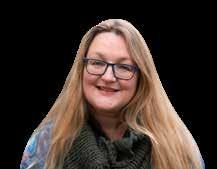




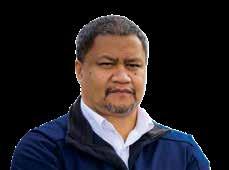
General Manager, Māori & Pacific Partnerships
MBA, Massey University, BA (Māori Resource Management) and BCA (Management and commercial law), Victoria University of Wellington Marino provides strategic leadership for NIWA’s research and applied science services for Māori, with the aim of maximising the transfer of environmental and natural resource scientific knowledge to whānau, hapū, iwi, Māori entities and communities – for the economic, social, cultural and environmental benefit of the nation. He joined NIWA in 2015 from Landcare Research, where he was the Māori Partnerships Manager –Business Development since 2006. His tribal affiliation is Ngāi Tūhoe, and he comes from Ruatahuna, a small settlement in Te Urewera.
General Manager, Research Strategy
PhD (Atmospheric Chemistry), York University of Canada
Alex joined NIWA in 2017 after a decade in government in climate policy advice and as a science investment manager. Before returning to New Zealand, Alex was a founding editor of Natural Geoscience, and previously held scientist roles at British Antarctic Survey in Cambridge UK, University of California at Berkeley, and Forschungszentrum Jülich in Germany.
Aquaculture – Chief
DVM, University of Prince Edward Island
Andrew joined NIWA in 2005, after more than 20 years’ experience in North American and European aquaculture. He has extensive expertise in the design and operation of recirculating aquaculture systems and has managed freshwater production for a major salmon farming company. Andrew took up his current role in 2007.

Climate, Atmosphere & Hazards –
Chief Scientist
PhD (Climatology), University of Colorado
Andrew joined NIWA in 2000. His research areas of interest are climate change impacts and implications, adaptation to climate change, spatial modelling of climate, and sector and business applications of climate data. He was seconded to MPI in 2017 to contribute to the Primary Sector Science Roadmap and to DOC from 2017 to 2019 to work on their Climate Change Adaptation Action Plan.
Climate, Atmosphere & Hazards – Manager

BSc (Hons) Geography, University of Auckland
Nava joined NIWA in 2014 as a climate scientist, initially focusing on climate cycles and climate change projections. She upskilled in operational meteorology with the UK Met Office and began working with NIWA’s Forecasting Services team to deliver forecasts, develop new products for clients and visualise data in innovative and engaging ways. Nava regularly engages with the public, media, business and other organisations about weather and climate.
PhD (Earth Sciences), University of Waikato Scott is a coastal hazards scientist who joined NIWA in 2001. He specialises in extreme sea-level and wave analysis and assessment of coastal hazards for adaptation to sea-level rise. Before becoming Chief Scientist, Coast & Estuaries in 2021, Scott was Assistant Regional Manager in Hamilton.
PhD (Ecology & Evolutionary Biology), University of Connecticut
Drew has worked for NIWA since 2002 and has extensive expertise in marine seafloor ecology in temperate coasts and estuaries and Antarctic coastal environments. This includes primary production and nutrient dynamics in soft-sediment habitats, animal-sediment interactions, disturbance-recovery processes, and ecosystem functioning. He took up his current role in 2021.


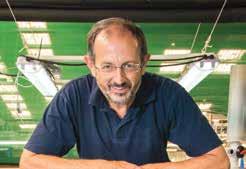
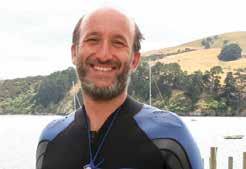
Environmental Information –Chief Scientist
PhD (Geography), University of Bonn
Jochen has a cross-disciplinary research background in hydrology, geomorphology, soil science, geo-informatics, and hazards and risk assessment. He joined NIWA in 2003 and since 2010 has led NIWA’s environmental information research and developments, ensuring that systems for collecting and managing NIWA’s data are robust and meet best-practice standards.
Fisheries – Chief Scientist
PhD (Marine Science), University of Otago Richard specialises in research aimed at improving estimates of fish abundance using acoustics, trawling and complementary technologies. He has extensive seagoing and practical fisheries experience in New Zealand and overseas, including the Antarctic. Richard is a past chair (2017–19) of the ICES Working Group on Fisheries Acoustics Science and Technology. He has worked at NIWA since 2000 and took up his current role in 2021.
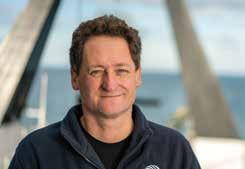

Fisheries Centre Operations – Manager
BSc Marine Biology, University of Waikato
Chloe has a diverse background in project and programme management. During her studies she worked with Ngāi Te Rangi funding to explore habitat construction and reseeding of juvenile pāua in the Tauranga Moana Mātaitai. Since joining NIWA in 2015, Chloe has held previous roles with the Fisheries Centre, and as Challenge & Engagement Manager of the Sustainable Seas National Science Challenge.
Freshwater & Estuaries – Chief Scientist
PhD (Ecology and Evolution), University of Hawai’i

Scott is an ecosystems ecologist with expertise in freshwater and marine water quality and algae. He has carried out research in settings including coral reefs, rivers, rainforests, estuaries, lakes and aquifers.
At NIWA, Scott has led research in water quality, environmental flows, and surface water-groundwater science since 2001 and took up his current role in 2018.
Freshwater & Estuaries – Manager
PhD (Environmental Chemistry), Queensland University of Technology
Neale is an organic chemist with a research background in natural product chemistry and organic synthesis, odour emission and mitigation research and water quality assessment. Recently he has focused on understanding information hidden within high-frequency water quality data and evaluating the efficacy of devices used for mitigating agricultural contaminants. He joined NIWA in 2007 and was appointed to his current role in 2019.

High Performance Computing & Data Science – Chief Scientist
PhD (Engineering and Computer Science), Victoria University of Wellington

Kameron has a research background in artificial intelligence (i.e., ML, DL and RL), digital signal processing (i.e., image, audio and sensors), and cognitive and affective neuroscience. He has extensive experience leading data and data science across a range of industries, including the financial and science sectors, and joined NIWA in 2019.
Māori Environmental Research –Chief Scientist
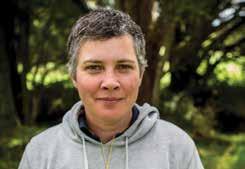
Pou Whakarae – Te Hiringa Taiao
PhD (Biological Sciences), University of Auckland
Erica joined NIWA in 1995 and has been a member of NIWA’s Te Kūwaha team since 2001. She has been involved in a wide range of research areas including bioaccumulative contaminants in mahinga kai species, understanding the values and priorities of Māori communities for the restoration of their freshwaters, taonga species-related research, and capacity building and monitoring frameworks for Māori communities.
Oceans – Chief Scientist
PhD (Physical Oceanography), University of Tasmania
Mike joined NIWA in 2001 and has a science background in physical oceanography, ocean acidification, climate change and ocean processes associated with Antarctic sea ice and ice shelves. Prior to his appointment as Chief Scientist, Oceans in 2021, Mike held a joint appointment as Director of the Deep South National Science Challenge and Principal Scientist, Marine Physics.
PhD (Geological Sciences), University of Canterbury
Joshu has worked for NIWA as a marine geologist for over 16 years. His areas of research expertise include active seafloor and sub-seafloor processes, with particular focus on active tectonics and earthquake hazards, submarine landslides and canyons, and offshore groundwater and fluid flow systems. He took up his current role in 2021.
Marine Biodiversity & Biosecurity –
Chief Science Advisor
PhD (Marine Ecology), University of Sydney
Graeme has a background in coastal ecology, environmental assessment, marine tourism and biosecurity. He joined NIWA in 2000 and he has led national and international programmes of research on risk assessment, surveillance and control of invasive marine species and has provided technical training and advice on marine pests and their management around the world.


Pacific Rim – Manager
MSc (Water Engineering), University of Strathclyde
Doug is a chartered engineer. He joined NIWA in 2003, following roles with HR Wallingford in the UK and the Government of Kosrae in the Federated States of Micronesia. He specialises in coastal hazard management and coordinates NIWA’s international commercial work, focusing on the Pacific and Asia regions.

Vessel Operations – General Manager
NZCE (Mechanical), Central Institute of Technology
Greg is a certified automotive engineer. Before joining NIWA Vessels as Engineering Manager in 2004, he managed a marine and industrial supply and repair company. He has also worked for Mitsubishi Motors, in various technical roles, in New Zealand, Australia and Europe. Greg has managed NIWA’s research vessels Tangaroa, Kaharoa and Ikatere since December 2010.
Marine Resources – Manager

BSc (Hons) (Environmental Science & Technology), Middlesex University
Rob is a chartered scientist with more than 26 years’ international experience. He has held senior management positions in environmental consultancy and science sectors in the UK, Australia and New Zealand. Rob joined NIWA in 2013 and has oversight of the NIWA vessel fleet and the application of marine science.
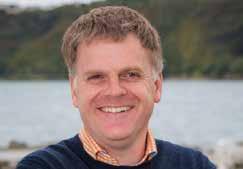
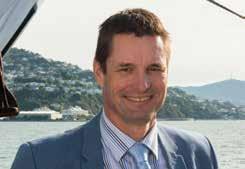
Marketing & Industry Engagement –Manager
PhD (Marketing and Technology Management), University of Waikato
Mark is an industrial marketer, and has led the marketing, product development, technology transfer and business-development effort for firms in the plastics, steel and primary sectors. He joined NIWA in 2009 and his past roles include National Marketing Manager for BHP Steel Building Products, National Marketing Manager for ICI Resins and Adhesives Division and General Manager for NorthFert.
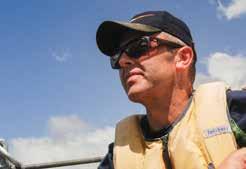
MSc Hons I (Geology), University of Canterbury
Alan has a background in ecology and earth sciences. He has extensive experience in research administration and science and technology programme evaluation. Alan joined NIWA in 1998 and oversees NIWA’s obligations to government funding agencies and responsibilities for undertaking research for the benefit of all New Zealanders, and evaluation of the impact and value of NIWA Research.
Chief Science Advisor
PhD (Environmental Geochemistry), McGill University, Canada
Chris joined NIWA as Chief Science Advisor in 2020. Most recently he held roles as Principal Science Lead at the Ministry for the Environment, and as Director of the Environment and Materials Division at GNS Science. He has research interests in groundwater quality, geomicrobiology and numerical flow and transport modelling of hydrological systems.

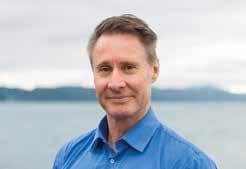
Strategy and Research Office –
Research Development Manager
BA (History), Victoria University of Wellington
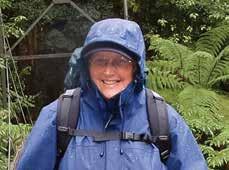

Sarah joined NIWA in 2022. Her background is in the public sector and fund management in areas such as the environment, tertiary education and foreign affairs. She has spent a decade working in science funding, including on MBIE’s Endeavour Fund.
PhD (Marine Biology), University of Otago
Barb has a research background in marine biosecurity and the environmental sustainability of aquaculture. Today she leads NIWA’s coasts and oceans research, which focuses on ecosystem-based approaches to managing activities in New Zealand’s marine estate, so that economic and social benefits are realised while vulnerable components of the ecosystem are protected.
Auckland & Ruakākā – Regional Manager
MSc (Hydrology for Environmental Management), Imperial College, University of London.
Jonathan joined NIWA as an urban aquatic scientist in 2005, where he led applied research and consultancy studies to inform improved stormwater management in our towns and cities, and became Group Manager of the Urban Aquatic Environments team. He has been Regional Manager of NIWA’s Auckland office since 2019.

Christchurch – Regional Manager
PhD (Ecology), University of Canterbury

Phil is a freshwater fisheries scientist specialising in freshwater resource management and conducting research on freshwater fisheries and food webs.

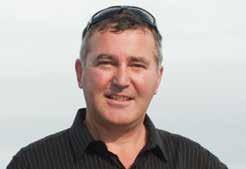

He currently leads large freshwater reconsenting projects for NIWA’s hydropower clients. He first joined NIWA in 2005, became Assistant Regional Manager in 2018 and was appointed to his current role in 2021.
Hamilton – Regional Manager
PhD (Aquaculture), University of Stirling Michael joined NIWA in 1999, and he has more than 25 years’ experience in aquaculture research and working with industry. In 2011 he was appointed Assistant Regional Manager for Auckland, managing our Northland Aquaculture Centre at Bream Bay. In 2019 he was appointed Regional Manager for the Hamilton region.
Nelson – Regional Manager
PhD (Applied Geology), University of New South Wales
Darren is a research scientist with experience spanning the earth and human-system sciences. He joined NIWA in 2001. In addition to being the Regional Manager for Nelson, he leads NIWA’s Māori Environmental Research Programme ‘Hazards, Climate and Māori Society’ and holds a joint position on the Kāhui Māori for the Deep South National Science Challenge and the Antarctic Science Platform.
Environmental Information Operations –National Manager
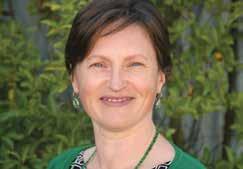
MSc Hons (Engineering Hydrology), National University of Ireland
Charles is a hydrologist specialising in the analysis of hydrological and other data for purposes such as estimating flood risks. He is also the World Meteorological Organization’s Hydrological Adviser for New Zealand. Charles joined NIWA in 1982 and has extensive staff and operations management experience. He was appointed to his current position in January 2016.
Science Delivery – National Projects Manager
PhD (Physical Geography),University of Hull Helen trained as a coastal geomorphologist. She joined NIWA in 2007, first as a resource management scientist, then from 2014 as National Projects Manager. She was Christchurch Regional Manager from 2016 until taking up her current role in 2021.
Wellington – Senior Regional Manager
PhD (Zoology), University of Auckland
Alison has broad experience in marine behavioural ecology, reef ecology and management, marine ecosystem risk assessment, closed area management, and historical marine ecology. She joined NIWA in 1993 and now leads the Wellington Regional Management Team, with a particular focus on the Future Property Programme. She also chairs NIWA’s Emergency and Crisis Management Critical Risk Team.
Wellington – Regional Manager
NZCE Electronics and Computer Science
Steve joined NIWA in 1991 and has worked within the marine geotechnical and hydrographic community for the last 36 years. During this time Steve has been on over 120 scientific and commercial voyages as well as over 30 land-based nearshore and lake surveys. Prior to his appointment as Regional Manager in 2019, Steve was the Group Manager Marine Technology.
Wellington – Assistant Regional Manager
PhD (Biochemistry), University of Otago

Judy is a molecular biologist specialising in phylogenetics and systematics. Since joining NIWA in 2015 she has led the NIWA Molecular Biology team, which works across several areas including biodiversity, biosecurity, aquaculture and fisheries.


She was Group Manager, Environmental Isotopes and Molecular Biology before her appointment as Assistant Regional Manager in 2020.
Māori Organisational Development – Manager

MSc Hons (Environmental Science), University of Waikato
Darcel’s focus is the implementation of NIWA’s bicultural organisational development strategy – enhancing existing processes, developing and leading new initiatives, and providing strategic advice and support. She also leads the science communication and outreach programme for Te Kūwaha, NIWA’s Māori workforce development and cultural competency programme, and Te Piko o te Māhuri, NIWA’s Māori capability development programme.
This breathtaking Molesworth Station landscape caught the eye of the judges. They noted the sharpness of detail, and lovely saturated colours of the dramatic blue-grey clouds over the golden tussock landscape.
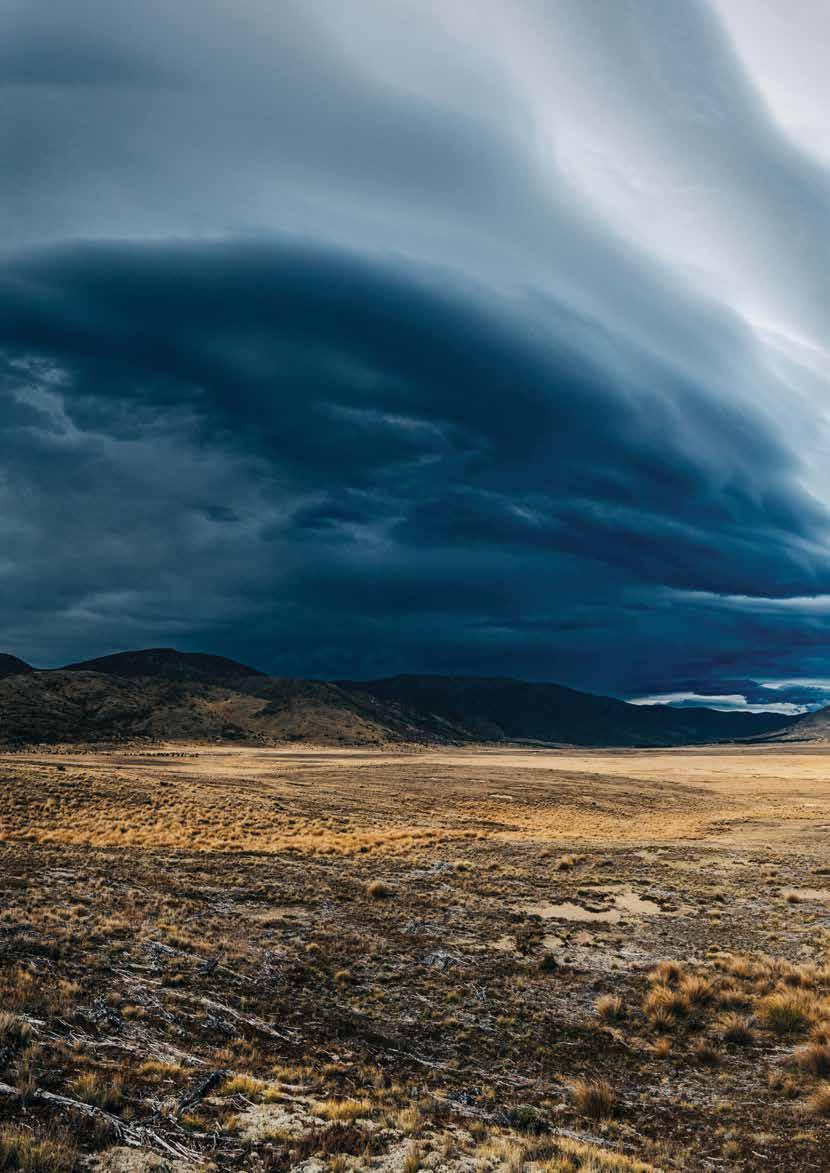
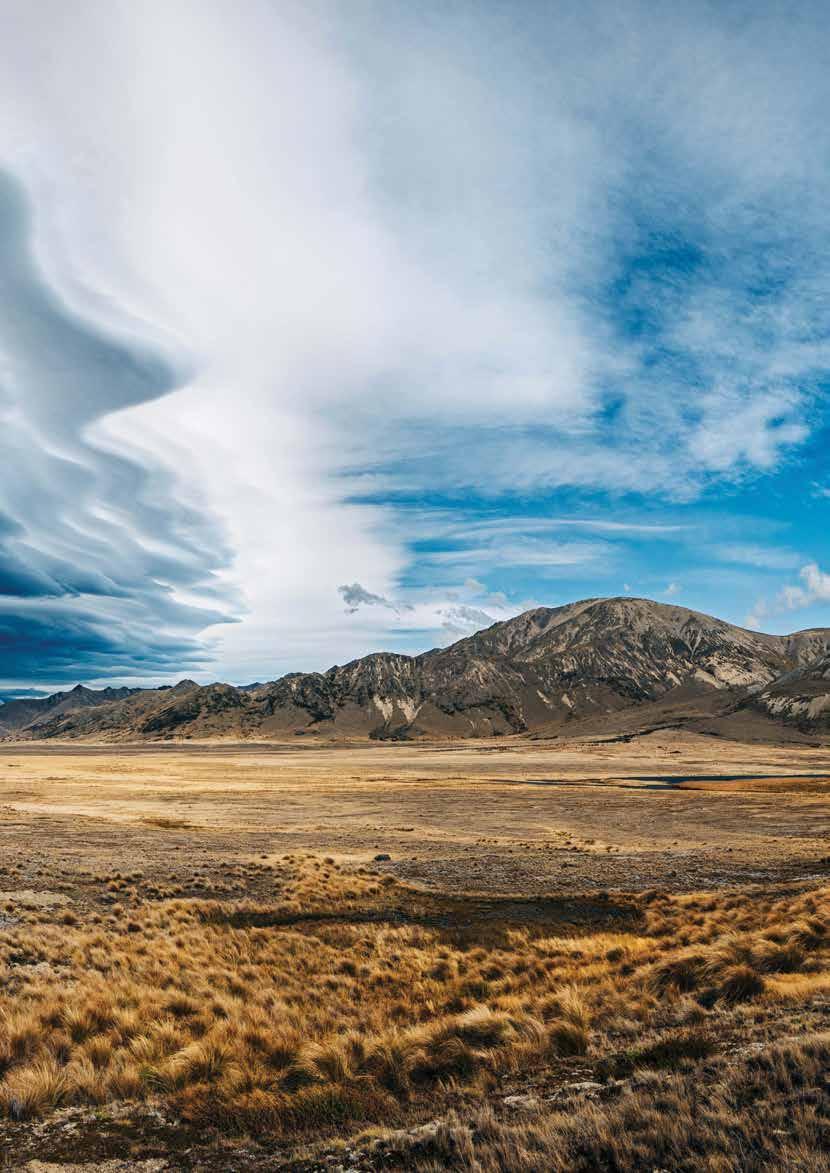
NIWA’s Māori name Taihoro Nukurangi describes our work as studying the waterways and the interface between the Earth and the sky. Taihoro is the flow and movement of water (from tai ‘coast, tide’ and horo which means ‘fast moving’). Nukurangi is the interface between the sea and the sky (i.e., the atmosphere). Together, we have taken it to mean ‘where the waters meet the sky’.


